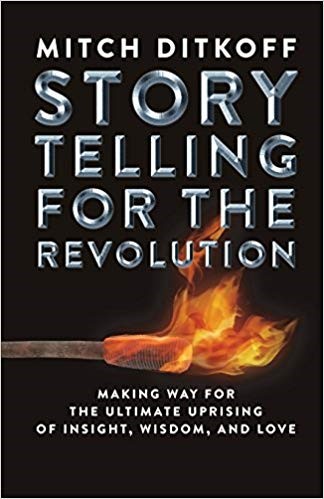FREE THE GENIE KEYNOTE: The Art & Science of Going Beyond Limiting Assumptions

If you are looking for a kickoff conference keynote that will energize, inspire and establish the kind of mindset conducive to real learning, engagement and commitment, keep reading...
As an internationally acclaimed thought leader in the field of innovation, I know how to spark breakthrough in even the most curmudgeonly conference attendee.
My Free the Genie keynote is a time-tested way to help audiences unlock and unleash their innate brilliance.
Since 1987, I have been working closely with more than 100 organizations in 11 different countries to help them go beyond the status quo and achieve extraordinary results. My keynotes go well beyond mere pep talks or inspired public speaking.
Yes, attendees become better informed about what it takes to innovate, but more than that they begin to transform -- navigating their way forward into new realms of possibility and solution-finding. I don't talk at people. Instead, I provide the kind of experience that enables people to participate in meaningful ways that translate into actionable business insights.
Each keynote includes the following elements:
- Establishing a culture of listening to ensure full engagement
- Building a solid case for the need to go beyond the status quo
- Topic-specific storytelling that makes it easy for attendees to remember key learning points
- Identification of individual limiting assumptions interfering with breakthrough results
- Identification of compelling questions that jump start insight
- Ideation and small group brainstorming
- The practice of at least one powerful creative thinking technique
- A 16-page guidebook to support the keynote learning process
- A sampling of Free the Genie cards to spark original thinking
- Cross-fertilization of best practices and newly articulated ideas
- Action planning and identification of next steps
What my clients say
Idea Champions
Ten Tips for Giving a Great Keynote
CONTACT: Mitch Ditkoff (mitch@ideachampions.com) -- 845.389.9096
Posted by Mitch Ditkoff at 10:28 AM | Comments (0)
July 30, 2021Inside/Out Innovation

If you work in an organization that wants to establish a sustainable culture of innovation -- you have two basic choices: outside/in or inside/out.
Outside/in is the most common approach. It assumes that re-engineering systems or processes is the way to go. You know the drill: do a little Six Sigma, cost cutting, continuous improvement, hire a few consultants to give pep talks and you're off to the races.
Not that there's anything wrong with that, mind you, but it's often just a slick way of repositioning the deck chairs on your own Titanic. It looks good. It sounds good. You feel like you're doing something, but the ship is still sinking.
The other approach -- inside/out -- is far less common. And why it's less common is because it's slower, initially more chaotic, requires more commitment and, to a lot of left-brained people, seems like voo doo.
The inside/out approach is based on the notion that "organizational change" follows individual change -- understanding, as it does, that an organization is nothing more than a collection of individuals.
The bottom line? Organizations don't change until the people in them do.

In the inside/out approach, each person commits to -- as Mahatma Ghandi put it -- to "being the change you want to see in the world."
Ah... personal responsibility! Personal accountability! Sustained commitment! Even when things get uncomfortable.
Real change does not begin with re-engineering. It does not begin with new initiatives, tweaked processes, compensation plans, reward systems, cost cutting measures, flex time, organic lunches in the cafeteria, or overpriced consultants telling you what to do.
Where does real change begin? It begins with a change of mindset -- what the dictionary defines as "the characteristic mental attitude that determines how you will interpret and respond to new situations."
Mindset, not skillset.
MINDSET -- why a pickpocket, every time he meets a saint, will only see pockets. MINDSET -- the cognitive filters we look through that color how we see the world. MINDSET -- why the CFO sees the problem as data, the Chief Marketing Officer sees it as branding, and the IT Director sees it as bandwidth.
The fact is: every single person in your company already knows what to do in order to foster a culture of innovation. They do. They really do. It's common sense. It's just that common sense has become uncommon these days.
Consultants like to make it mysterious, but it's actually very simple.
Does your company's longstanding history of bureaucratic, hierarchical, command-and-control get in the way of each individual operating at their highest potential? Of course it does.
Will re-engineering business processes help? Of course it will. And it is an important piece of the puzzle. But the real deal is NOT a "program". The real deal is each and every person in your organization bringing their innate wisdom to the table every single day. Their highest self. Their best self. Their naturally creative, authentic, passionate, collaborative, go-beyond-the-call-of-duty, opportunity-finding, accountable, engaged, on-fire-with-possibility self.
It's simple.
Simple, unfortunately, is not the same thing as "easy" -- especially these days where so many of us worship at the altar of complexity.
To be continued...
Idea Champions
What we do
What our clients say
Posted by Mitch Ditkoff at 01:01 PM | Comments (8)
June 17, 202120 Qualities of an Innovator

The word "innovate" can be traced all the way back to 1440. It comes from the Middle French word "innovacyon," meaning "renewal" or "new way of doing things".
Exactly what innovations actually happened in 1440 (rounder oxcart wheels?) is anybody's guess, but whatever they were, it's likely they improved the quality of life for more than a few people.
These days, the "innovation thing" is something of a no-brainer. Every company worth its low-salt lunch has identified innovation as a core competency needing to be developed.
Who in their right mind (or is it right brain?) can deny the value of improving things? Isn't this what human beings, those grand inventors of the microchip and the chocolate chip, are supposed to do?
True. But who has time?
And so begins the search for the magic pill -- the system, formula, or blueprint that will make innovation a done deal.
Innovation, unfortunately -- unlike audits, re-engineering, or your high school penmanship teacher -- is not given to systems, formulas, and blueprints. It is given to people -- restless, inspired, fascinated people with an almost cellular need to change things for the better.
And while it can certainly be supported by systems, it can never be reduced to systems.
If you want to ignite innovation in your organization, forget about slick formulas for a minute and pay attention to what's happening on the inside. Because that's where innovation starts. With the innovator -- the inspired individual, compelled to make a difference.
And the key to the innovator? The special blend of qualities that allows him or her to succeed while their co-workers are bitching and moaning on their way to their next unnecessary meeting.
Is it tools? Techniques? Metrics?
Sure, they're useful. But without the user of them having the right stuff, they're merely decoration -- like having a shiny set of new jumper cables, but no car.
And so... if you are one of the self-chosen few who are willing to stop blaming your organization, the economy, your boss, your industry, the government, HR, your mother, your astrological sign, the Board, and the bored, now's the time to start taking personal responsibility for innovating.
Now's your chance to kick things in high gear.
Now's the time to get the lead out -- to lead the revolution wherever you happen to be working at the time and make some magic.
Yes, it begins with you. But where does it begin with you?
With awareness.
In the words of the great psychologist, Fritz Perls, "awareness cures." Yes, it does. Still with me?
If so, take a few minutes now to try the following exercise to get the party started.
All you need to do is rate yourself, on a scale of 1-10, for how much you manifest the following qualities in the workplace. Note which ones are your strengths -- and how can you build on them. Then note which ones are your weaknesses -- and how can you strengthen them.
You might even give them to your team and ask them to rate themselves. Then get together and talk about what you've all come up with.
And don't forget to floss.
20 Qualities of an Innovator
1. Challenges the status quo
2. Curious
3. Self-motivated
4. Visionary
5. Entertains the fantastic
6. Takes risks
7. Peripatetic (moves about)
8. Playful/humorous
9. Self-accepting
10. Flexible/adaptive
11. Makes new connections
12. Reflective
13. Recognizes patterns
14. Tolerates ambiguity
15. Committed to learning
16. Balances intuition and analysis
17. Situationally collaborative
18. Formally articulate
19. Resilient
20. Persevering
This posting is excerpted from It's AHAppening, a series of five, 16-page creative thinking guidebooks.
Posted by Mitch Ditkoff at 01:38 PM | Comments (1)
July 09, 2020The DNA of Idea Champions Workshops and Trainings

Most people think that the ability to be innovative is a mystical state available only to the chosen few.
The effort, they imagine, takes a lot of time and hard work. And since they don't have time and don't like hard work, they reason that innovation just isn't in the cards for them.
But innovation is not a mystical state. It's a natural state -- a human birthright. The people in your organization, in fact, already are innovative. The only thing is: their natural ability to be innovative is being obscured by their own habits of mind and a variety of bothersome organizational constraints.

Their challenge is the same one as seeing the "hidden" arrow in the FedEx logo (look between the "E" and the "X").The arrow has always been there, but most people never notice it.
This is the work of Idea Champions. We help people see what they already have, but don't know how to access.
We help people make meaningful adjustments of vision, insight, and perception so they can acknowledge, embrace, and apply their innate ability to be more creative on the job -- and, for those clients who want to reinvent their "innovation process", we help them figure it out.
What follows is a brief summary of how we do this...
1. Know Thy Customer:
Long before we ever get into a room with participants, we do our due diligence -- learning about WHO we are serving, WHAT they expect, and HOW our time with them will be the most significant.
Sometimes this takes the form of phone interviews. Or online polls. Or studying key documents our clients send us in order to understand their current reality, industry, business challenges, organizational constraints, and hoped for outcomes.
2. Customization:
Based on our assessment of our client's needs, we put together a game plan to get the job done. Towards this end, we draw on more than 100 "innovation-sparking" modules we've been developing since 1986.
3. Co-Creation:
Early in the design process, we invite our clients to give us feedback about our approach. Their feedback stirs the creative soup and provides us with the input needed to transform a good session design into a great one.
4. Spacing In:
We make a great deal of effort to ensure that the space in which our sessions take place are as ideal as possible. Form may follow function, but function also follows form.
When participants walk into an Idea Champions session, they begin "mind shifting" even before the session begins. It is both our belief and experience that culture/environment is a huge X factor for creativity and innovation.
5. Drive Fear Out of the Workplace:
W. Edwards Deming, one of America's most revered management consultants, was a big proponent of removing fear from the workplace. So are we. Towards that end, each of our sessions begins with a norm-setting process that makes it easy for participants to establish a dynamic culture of innovation for the day.

6. Mindset:
Organizations don't innovate, people do. But not just any "people." No. People who are energized, curious, confident, fascinated, creative, focused, adaptive, collaborative, and committed.
People who emerge from our sessions are significantly more in touch with these "innovation qualities" than when they began. Their minds have changed. They see opportunities when, previously, all they saw were problems.
They let go of perfectionism, old paradigms, and habitual ways of thinking. In their place? Open-mindedness, listening, idea generation, original thinking, full engagement, and the kind of commitment that drives meaningful change.
7. Balancing Polarities:
Human beings, by nature, are dualistic, (i.e. "us" vs. "them," "short-term" vs. "long-term," "incremental" vs. "breakthrough," "left brain" vs. "right brain".)
The contradictions that show up in a corporate environment (or workshop) can either be innovation depleters or innovation catalysts. It all depends how these seeming conflicting territories are navigated. Idea Champions is committed to whole-brain thinking -- not just right brain or left brain thinking.
Our work with organizations has shown us that one of the pre-conditions for innovation is a company's ability to strike the balance between these polarities.
Each workshop we lead and each consulting engagement we commit to is guided by our understanding of how to help our clients find the healthy balance between the above-noted polarities.
8. Expert Facilitation: "A rock pile ceases to be a rock pile when someone contemplates it with the idea of a cathedral in mind," wrote St. Exupery.
This, quite simply, is what Idea Champions does. But we do far more than just contemplate. We also architect and build.
Since 1986, we've been facilitating innovation-sparking engagements for a wide variety of industries. We have mastered the art and science of turning lead (or leaders) into gold. And we can train your people to do the same thing we do.
9. Experiential Challenges: "What I hear, I forget. What I see, I remember. What I do, I understand."
So said the great Chinese sage, Confucius. This 14-word quote describes the essence of our work. Simply put, we get people off their "ifs, ands or buts," and into the experience of what's possible.
While we value theory, research, models, data, best practices, business cases, and most of the other flora and fauna of business life, we've come to understand that the challenge of sparking insight, breakthrough, and change, is best accomplished by doing -- not talking.
That's why all of our sessions include experiential challenges that provide participants with visible ways of seeing innovation in action -- what supports it and what obscures it.
10. Emergent Design: Awakening the creativity of an organization's workforce is not a follow-the-dots exercise.
Although all of our interventions begin with carefully crafted project plans and agendas, our facilitators are fluent in the art and science of making the kind of real-time adjustments, refinements, and improvisations that are the difference between a good session and a great session.
Facilitators who attempt to imitate our approach find it difficult to succeed without first learning how to master the art of emergent design. The good news is that it can be learned -- and this is just one of the things we teach in our Train the Trainer programs.
11. Edutainment: Idea Champions sessions are a hybrid of two elements: education and entertainment. We know that when participants are enjoying themselves their chances of learning increase exponentially.
That's why we make all of our sessions a hybrid of education and entertainment. Participants do not get tired. They do not get bored. They do not sneak long looks at their smart phones.
12. Full Engagement: Idea Champions sessions are highly participatory. Our facilitators are skilled at teasing out the brilliance of participants, regardless of their social style, job title, or astrological sign.
But perhaps more importantly, our facilitators know how to help participants tease out each others' brilliance. Eventually, everyone gets into the act. The shy people take center stage and the power players take a back seat. The collective wisdom in the room gets a much-needed chance to be accessed and expressed.
13. Convergence: Idea Champions is successful because what we do works. And one of the reasons WHY it works is because our sessions help participants translate ideas into action.
Ideas are powerful, but they are still only the fuzzy front end of the innovation process. Ultimately, they need to turn into results. Creativity needs to be commercialized. Our workshops, trainings, and consulting interventions help our clients do exactly that.
14. Tools, Techniques, and Takeaways: Ideas Champions closes the gap between rhetoric and reality. We don't just talk about innovation or teach about it -- we spark the experience of it. And we do that in very practical ways.
One way is by teaching people how to use specific, mind-opening techniques to access their innate creativity. Another way is by providing our clients with a variety of innovation-sparking guidelines, processes, and materials that can be immediately used on the job.
Idea Champions
Creating a Culture of Innovation
Storytelling at Work
Brainstorm Facilitation Training
What our clients say
Posted by Mitch Ditkoff at 04:06 PM | Comments (1)
May 07, 2020The Innovation Burnout Syndrome

Most newly launched organizational innovation initiatives have a dark side, a not-much-talked-about shadow side. And it is this... fascinating new projects are conceived, senior leaders get excited, game plans are drawn up, but no one gives the "worker bees" any more time to devote to the newly launched projects. They are, in effect, expected to shoehorn their new efforts into their already overloaded schedules.
Bottom line, aspiring innovators' "day jobs" end up colliding with newly launched innovation initiatives and mayhem ensues. People either burn out, get cranky, triangulate to third parties, spend way too much time explaining the newly launched innovation project to others, or else go into martyrdom-mode -- all behaviors that do not bode well for the individual, the company, or its customers. And while every company DOES have a few superstar self-starters who dive in with both feet, this is not a formula for sustainable innovation.
The solution? Either redistribute workloads, offer "innovation project sabbaticals", or provide your front line innovators with enough support services to unclutter their minds, ease their way forward, and allow them the time to focus on the innovation job at hand without frying.
Oh, I almost forgot -- you can stagger the launch of new initiatives so not everything is happening at the same time.
If you don't, expect nothing but a whole lot of chaos, broken promises, unfulfilled expectations, and the kind of innovation backlash you wish you hadn't unleashed.
Posted by Mitch Ditkoff at 11:28 PM | Comments (0)
January 07, 2020GUY KAWASAKI on The Top Ten Mistakes of Entrepreneurs
This is absolutely brilliant! Fantastic content, authentic delivery, entertaining, and provocative. If you are an aspiring entrepreneur, this is required viewing. But even if you're not trying to raise venture capital, you can still learn a lot from Guy simply by tuning into the way he makes his pitch. And his Art of the Start is a treasure.
Posted by Mitch Ditkoff at 04:26 PM | Comments (0)
December 11, 2019On Creating an Innovation Mindset

If you want to spark innovation in your organization and are looking for the diamond cutters stroke, consider storytelling. Since 1987, I've tried everything under the sun to help my clients raise the bar for innovation. What I've discovered is that innovation begins in the mind and that unless people are in the right mindset, innovation will never be more than a pipe dream. Storytelling, I've learned, is the simplest, fastest, most memorable way to get people into an innovation mindset. Here's how we do it. And if you only have 90 minutes, this is how we do it. Its also boosts employee engagement.
I wrote the book
The back story
In our clients words
Posted by Mitch Ditkoff at 11:10 AM | Comments (2)
October 06, 2019A Real Life Example of the Power of Giving Feedback

Most Fortune 500 companies have some kind of corporate strategy in place for ratcheting up their innovation efforts. Consultants are hired. CEOs give pep talks. And internal initiatives are launched.
To the casual observer, it all looks good, but few of these initiatives ever amount to anything In fact, research indicates that 70 percent of all change initiatives fail.
Why such a low percentage? It depends on who you ask. Senior leaders see it as a workforce issue. The workforce sees it as a senior leader issue. Consultants see it as an issue their company is best suited to resolve. And the occasional in-house astrologer sees it as a Gemini in Pluto issue. Bottom line, nobody really knows.

Here's how I see it: one of the biggest (and least addressed) reasons why most change initiatives fail can be traced back to the cro-magnon way most innovation-seeking people give and receive feedback -- especially when it comes to pitching high concept ideas.
Case in point: Some years ago, Lucent Technologies asked me to facilitate a daylong "Products of the Future" ideation session for 75 of their best and brightest. The pay was good. The challenge was compelling. And I was going to have carte blanche to design the session just the way I wanted.
Or so I thought.
The woman who had contacted me, I quickly found out, reported directly to the CEO. So far, so good. And her concept of the session was spot on -- that the CEO and his Direct Reports (a new rock band?), would make an appearance at the end of the day to listen to five BIG IDEA pitches and then give their feedback, real-time.
Theoretically, this made perfect sense. But theory and reality are two very different things -- kind of like the difference between asking your teenage daughter to clean up her room and her actually doing it.
The harsh reality is this: The vast majority of Senior Leaders are not very skillful when it comes to giving feedback -- especially in response to ideas that challenge the status quo. "Feedback," for them, has become code for "With all due respect, let me tell you why your idea sucks".
As a facilitator of high profile brainstorming sessions, I cannot, in good faith, allow this all-too-predictable dynamic to play itself out. Not only will potentially profound ideas be prematurely dismissed, the hard-working, brilliant people who have spent all day generating and developing these ideas will become royally pissed, disempowered, humiliated, passive/aggressive, and depressed. The result? Very few of them will want to participate in future sessions.
So I told the consultant-seeking woman from Lucent that I, in service to the outcomes she was about to hire me to ensure, needed to meet with her CEO so I could teach him and his team how to give effective, humane feedback to a roomful of 75 future product generating optic fiber geniuses.
 "Impossible!" was her response. "Our CEO is very busy man -- and besides... he doesn't like consultants."
"Impossible!" was her response. "Our CEO is very busy man -- and besides... he doesn't like consultants."
"Got it," I said, quickly assessing my options. "And thank you, so much, for your kind invitation to facilitate the session, but I must respectfully decline" -- and, with that, I began packing up my briefcase.
This, shall we say, caught her slightly off guard. "I... don't understand where you are going with this," she replied.
"Look," I said. "If you want to get meaninful results from an all-day brainstorming session, especially if you are flying people in from who knows where, we've got to be absolutely sure that the feedback at the end of the day is done well. I am not going to walk 75 of your best and brightest people off the plank."
I could tell that my unexpected feedback was registering. "OK, OK...but the best I can do is get you five minutes with him during the coffee break just before the report outs".
"Great," I said. "I'll take it."
Fast forward two months.
From 8:30 am -- 3:00 pm, 75 of Lucent's most brilliant technologists conjured up products that made my head spin. The room was abuzz with glorious possibilities. The sense of accomplishment was palpable. At 2:45 they selected five of their best ideas and summarized them on flipcharts. At 3:00, it was time for coffee and sugar, me craning my head for the CEO and his merry band of direct reports.
I envisioned him to be a tall man, silver-haired, with a large Rolex and a steely look in his eyes -- someone who might be good friends with the Governor and eventually have his portrait hanging in the lobby at headquarters. He was, much to my surprise about 5'6", wearing a Mickey Mouse t-shirt, loafers, and no socks. My kind of guy.
"Rich," I began, extending my hand. "Welcome, Mitch Ditkoff here from Idea Champions, facilitator of today's extraordinary ideation session, "how would you like to learn a simple technique in the next five minutes that will not only take all the dread out of giving feedback, but spark some seriously powerful idea development on the spot?"
He looked at me as if I'd just given him the holy grail. "You're on!"
"Great. Here's how it works," I began. "When an idea is pitched, first say what you LIKE about it -- the upside, what's promising. After a few genuine likes, then express your CONCERNS -- the stuff you probably wanted to say in the first place. But for each concern you express, it will be your responsibility to follow it with a SUGGESTION, a way that would resolve your concern and keep the idea alive Got it?"
"Got it."
"Oh... one more thing, Rich. If you forget to use the method, do I have your permission to remind you?"
"Absolutely".
The senior team took their place on stage, sitting behind a table, draped in black, that reminded me of the Nuremberg Trials. The 75 brilliant brainstormers took their seats at round tables -- everyone attentively listening to me describe the feedback process that was just about to unfold.

The first BIG IDEA pitch was excellent -- a compelling idea for a telecommunications platform of the future that was utterly mind blowing. The audience applauded, I acknowledged the presenter, and then gave the floor to the CEO, reminding him to use the feedback technique I'd taught him just a few minutes ago -- which he proceeded to do for, oh, maybe 30 seconds or so.
After that? It was Apocalyse Now meets The Godfather, with a little Don Rickles in Vegas thrown in for good measure, a scene I'd witnessed countless times before in corporate America -- the kneejerk, reptilian-brained, go-for-the-jugular tendency most senior executives have to focus on what's wrong with a new idea before what's right.
Speaking into the mic in my best baritone imitation of the Wizard of Oz, I quickly intervened.
"Oh Mr. CEO of a very large and profitable telecommunications company. Remember the LCS technique! First your LIKES, then your CONCERNS, then your SUGGESTIONS."
In an optic fiber nanosecond, he sheepishly smiled, thanked me for the reminder, and returned to the technique.
The rest of the session went off without a hitch. Five powerful ideas got pitched. Seven of Lucent's top executives weighed in with insight, honesty, and graciousness. And 75 aspiring innovators experienced something they had probably never experienced before -- that it was possible to spend all day brainstorming "out there" possibilities and get the kind of feedback from senior leadership that was honorable, empowering, easy-to-listen to, and immediately helpful.
SO WHAT? Ever hear the phrase "ideas are a dime a dozen." Of course you have. It's one of the classic truisms we were all brought up to believe. That old saw, however, is less about ideas being inconsequential, than it is about people not knowing how to elicit their value. Granted, not every idea is worth developing, but far too many good ones are lost along the way because the person to whom the idea is pitched is blinded by their own knee jerk reactions.
The literature is filled with examples of great ideas whose value was not immediately recognized. The steam engine. The MacIntosh. FedEx. And the Post-It Note just to name a few. All of them were pitched to the "powers-that-be" and all were victims of knee jerk, naysaying, idea killing behavior. Yes, it's true, many senior leaders beat the drums for "out of the box thinking". But when push comes to shove, as it often does, their drumming is more like fingernails on the edge of an office desk than a conga player with fire in his eyes. So let's give our senior leaders what they need to make the shift from theory to practice -- and that is a simple method for them to respond to new and untested ideas in a way that increases the odds of innovation actually happening.
NOW WHAT? Think about your style of responding to new ideas. Do you listen? Do you pause long enough to see the seed of innovation? Do you give meaningful feedback in a humane way? And what about your organization? Do people know how to give and receive feedback? Do they take the time? Does the process increase the odds of innovation becoming a reality? If not, what can you about it this week to turn things around?
Posted by Mitch Ditkoff at 06:46 PM | Comments (0)
August 14, 201976 Surprising Facts About Corporation Innovation
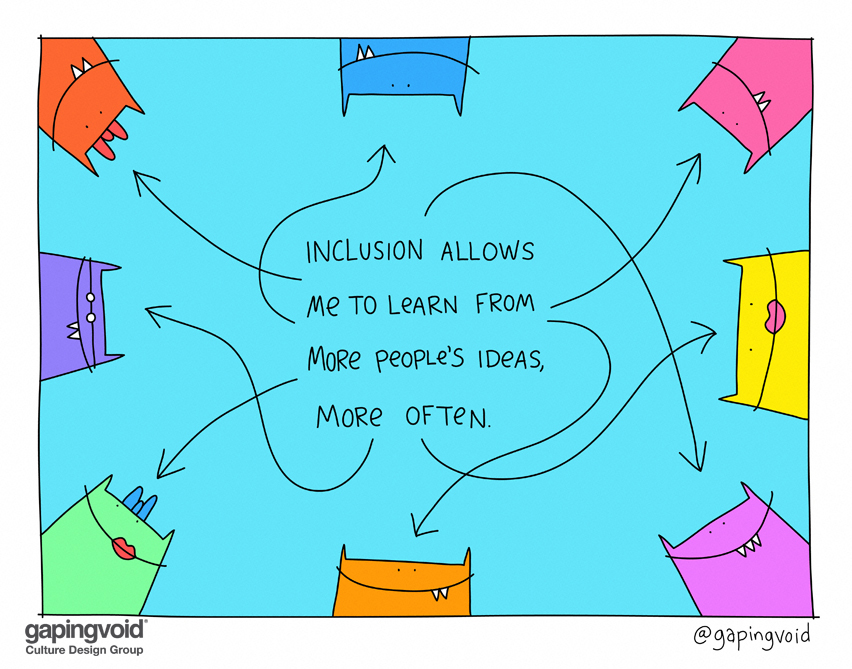
Here are 76 fascinating facts on corporate innovation curated by Valuer in Denmark. And while it's true that Canadian researchers have determined that goldfish have a longer attention span (9 seconds) than human beings (8 seconds), I have great confidence in your ability to buck this trend and focus for the three minutes it will take to read Valuer's post (unless you are multi-tracking or feeding your goldfish).
Illustration: gapingvoid
56 reasons why most corporate innovation efforts fail
Idea Champions
Posted by Mitch Ditkoff at 10:47 AM | Comments (0)
July 28, 2019What IS Innovation, Anyway?

If you google "definitions of innovation," guess how many references you will get? 177,000,000! That's a whole lot of attempts at defining something most of us want, but can't quite agree on what it actually is. Obviously, there IS no single definition. Like reality, it all depends on the person and their point of view. Still, it's useful coming to terms with what you think it is -- especially if you are about to enter into some kind of "innovation sparking process" with others. So, here are 13 definitions of innovation to get the party started. Choose the one that best works for you and then contemplate it. If NONE of the choices below work for you, create your own. Then, enter into a dialogue with your colleagues or team about what innovation means to them.
"The act of introducing something new." -- The American Heritage Dictionary
"Change that creates a new dimension of performance." -- Peter Drucker
"The ability to deliver new value to a customer." -- Jose Campos
"The commercialization of creativity." -- Anonymous
"The conversion of knowledge and ideas into a benefit, which may be for commercial use or for the public good."-- Queensland (Australian) government
"The successful exploitation of new ideas." -- UK Department of Innovation and Skills
"Imaginative activity to produce outcomes that are both original and of commercial value." -- The Institute for Innovation and Information Productivity
"The transformation of idea to reality." -- Saul Shapiro
"The managed effort of an organization to develop new products, new services, or new uses for existing products or services." -- Ricky W. Griffin
"The ability to adapt, adjust, or alter that which already exists for the sake of meeting a need or adding value." -- Anonymous
"The creation, development and implementation of a new product, process or service, with the aim of improving efficiency, effectiveness, or competitive advantage." -- Government of New Zealand
"The successful implementation of creative ideas within an organization.-- Teresa Amabile
"Creating something new before people know they need it." -- Guy Kawasaki
Idea Champions
One way to spark innovation
Do you know what problem you are solving for?
Creating the Innovation Mindset
Posted by Mitch Ditkoff at 09:52 AM | Comments (0)
June 27, 2019The Paradox of Innovation

My big insight about innovation these days would make Nobel Prize winner, Niels Bohr, proud.
"Now that we have met with paradox," explained Dr. Bohr, "we have some hope of making progress."
Innovation is full of it -- paradox, that is.
On one hand, organizations want structures, maps, models, guidelines, and systems. On the other hand, that's all too often the stuff that squelches innovation, driving it underground or out the door.
The noble search for a so-called "innovation process" can easily become a seduction, addiction, or distraction whereby innovation is marginalized, deferred, over-engineered, and worn like a badge.
True innovation is about allowing room enough for paradox to be a teacher and guide -- and to accept, at least for a little longer than usual, ambiguity, dissonance, and discomfort -- the age-old precursors to breakthrough.
Remember, there's a big difference between Six Sigma and Innovation.
Six Sigma is about reducing variability. Innovation is about increasing it-- and that often means allowing the kind of "messiness" that process-mavens interpret as a problem needing to be fixed, rather than a pre-condition to breakthrough and the resulting commercialization of that breakthrough that most people refer to as "innovation."
Yes, process, structures, systems are necessary, but they don't have to become overly pre-emptive. If you stay in an innovative mindset and can adapt to emerging needs, they will eventually become self-organizing when the soul of innovation is allowed to flourish.
Can we help the "innovation process" along with the right application of strategy, infrastructure, and planning?
Of course we can.
But beware! "Helping" the process too much often becomes counterproductive -- much in the same way that attempting to catch a milkweed floating through the air with a bold reach of your hand actually repels the object of your desire.
Innovation Physics 101.
Illustration: gapingvoid
Posted by Mitch Ditkoff at 02:24 AM | Comments (3)
March 16, 2019The Good Thing About Bad Ideas
One of the inevitable things you will hear at a brainstorming session is "there are no bad ideas." Not true. There are plenty of bad ideas. Nazism, for instance. Arena football. Bow ties.
What well-meaning "keep hope alive" brainstorming lovers really mean is this: Even bad ideas can lead to good ideas if the idea originators are committed enough to extract the meaning from the "bad".
Do you think that War and Peace was written in one sitting? No way. There were plenty of earlier drafts that were horrid, but eventually led to the final outcome.
The key? Finding the value in what seems to be a "bad idea" and then using that extracted value as a clue or catalyst for further exploration. The following technique, excerpted from Awake at the Wheel, shows you how...
HOW IT WORKS:

1. Identify a challenge worth brainstorming.
2. Conjure up a bad idea in response to it.
3. Tell someone about your bad idea.
4. Ask the other person to express something redeemable about your bad idea -- an aspect of it that has merit.
5. Using this redeemable essence as a clue, brainstorm some new possibilities
Idea Champions
Brainstorm Champions
Brainstorm now, online!
Posted by Mitch Ditkoff at 06:59 AM | Comments (0)
February 17, 2019Innovation as a Happy Accident

A little known fact about innovation is that many breakthroughs have not been the result of genius, but "happy accidents" -- those surprise moments when an answer revealed itself for no particular reason.
The discovery of penicillin, for example, was the result of Alexander Fleming noting the formation of mold on the side of petri dish left uncleaned overnight.
Vulcanized Rubber was discovered in 1839 when Charles Goodyear accidentally dropped a lump of the polymer substance he was experimenting with onto his wife's cook stove.
More recently, 3M's post-it was also the result of an accident in the lab. Breakthroughs aren't always about invention, but the intervention required, by the aspiring innovator, to notice something new, unexpected, and intriguing.
LEARN FROM YOUR HAPPY ACCIDENTS:

1. Think about a recent project, pilot, or business of yours that did not turn out the way you expected.
2. Ask yourself if any of the unexpected results offer you a clue or insight about how you might proceed differently.
3. Instead of interpreting your results as "failure," consider the fact that the results are simply nature's way of getting you to see something new -- something that merits further exploration.
Excerpted from Awake at the Wheel
Idea Champions
MitchDitkoff.com
Posted by Mitch Ditkoff at 02:59 PM | Comments (3)
July 09, 2018The Only Risk is Not to Risk



50 quotes on risktaking
Idea Champions
MitchDitkoff.com
Posted by Mitch Ditkoff at 07:16 PM | Comments (0)
June 23, 2018Paul McCartney's Carpool Karaoke
Talk about innovation!
Posted by Mitch Ditkoff at 05:53 AM | Comments (1)
June 20, 2018How to Spark Innovation in Your Company in 10 Minutes Per Week

Do you work in an organization that is trying to raise the bar for innovation, teamwork, storytelling, and leadership, but doesn't have the budget to pay for trainings, keynotes, and workshops? Here's an alternative -- Idea Champions' Micro-Learning for Innovators service. It all happens online. At your own pace.
The price? YOU decide on the value of our service and make us an offer. 95% of the time we go with what our prospective clients suggest. 5% of the time we decline. Interested? mitch@ideachampions.com
Posted by Mitch Ditkoff at 10:23 AM | Comments (0)
June 14, 2018Great Feedback from a New Client

Dear Esteemed Heart of Innovation Readers:
There's a good chance you and I have never met, talked or exchanged emails. If you are a subscriber to this blog, our only connection has been you reading my postings from time to time, 95% of which have been intended to help you discover new and better ways to think out of the box, innovate, and achieve extraordinary results. 5% of my postings are intended to give you a flavor of what Idea Champions does, can do, and has done -- so YOU, assuming you have a budget, can make an informed choice about inviting us in to your organization.
This is one of those times.
Just last week, I facilitated a day-long innovation workshop for 40 members of Toyota's Integrated Vehicle Systems department in Ypsilanti, Michigan. Suffice it to say, the session was a big hit. Here's what the forward thinking, committed, and very handsome Nick Sitarski had to say about the experience:
"Recently I was placed in a position to lead a new department related to advanced technology. I needed to find a way to bring a new team together and further enhance our innovative spirit. As I recently had training with Mitch Ditkoff from Idea Champions, I decided to engage him in creating a unique training session for my new department. After a couple months of pre-work, our training took place last week. Throughout the session, there was a perfect blend of education and entertainment. As a result, team members we fully engaged all day. My goals of bringing a new team together and enhancing our innovative spirit were met way beyond expectation.
Want to find out more? info@ideachampions.com
Idea Champions
Our clients
What they say
Posted by Mitch Ditkoff at 10:24 AM | Comments (0)
June 07, 2018100 Simple Ways to Be More Creative on the Job

1. Ask the most creative people at work for their ideas.
2. Brainstorm with a co-worker.
3. Tape record your ideas on your commute to and from work.
4. Present your challenge to a child.
5. Take your team off-site for a day.
6. Listen to your inner muse.
7. Play music in your office.
8. Go for a daily brainstorming walk.
9. Ask someone to collaborate with you on your favorite project.
10. Exercise during your lunch break.
11. Turn on a radio at random times and listen for a message.
12. Invite your customers to brainstorming sessions.
13. Think of new ways to define your challenge.
14. Remember your dreams.
15. Reward yourself for small successes.
16. Introduce odd catalysts into your daily routine.
17. Get out of the office more regularly.
18. Give yourself an unreasonable deadline.
19. Take more naps.
20. Jot down as many ideas as possible in five minutes
21. Work in cafes.
22. Transform your assumptions into "How can I?" questions.
23. Conjure up a meaningful goal that inspires you.
24. Redesign your office.
25. Take regular daydreaming breaks.
26. Dissolve turf boundaries.
27. Initiate cross-functional brainstorming sessions.
28. Arrive earlier to the office than anyone else.
29. Turn a conference room into an upbeat think tank room.
30. Read odd books that have nothing to do with your work.
31. Block off time on your calendar for creative thinking.
32. Take a shower in the middle of the day.
33. Keep an idea notebook at your desk.
34. Decorate your office with inspiring quotes and images.
35. Create a headline of the future and the story behind it.
36. Choose to be more creative.
37. Recall a time in your life when you were very creative.
38. Wander around a bookstore while thinking about your challenge.
39. Trust your instincts more.
40. Immerse yourself in your most exciting project.
41. Open a magazine and free associate off of a word or image.
42. Write down your ideas when you first wake up in the morning.
43. Ask yourself what the simplest solution is.
44. Get fast feedback from people you trust.
45. Conduct more experiments.
45. Ask yourself what the market wants or needs.
46. Ask "What's the worst thing that could happen if I fail?"
47. Pilot your idea, even if it's not ready.
48. Work "in the cracks" -- small bursts of creative energy.
49. Incubate (sleep on it).
50. Test existing boundaries -- and then test them again.
51. Schedule time with the smartest people at work.
52. Visit your customers more frequently.
53. Benchmark your competitors -- then adapt their successes.
54. Enroll your boss or peers into your most fascinating project.
55. Imagine you already know the answer. What would it be?
56. Create ground rules with your team that foster new thinking.
57. Ask stupid questions. Then ask some more.
58. Challenge everything you do.
59. Give yourself a deadline -- and stick to it.
60. Look for three alternatives to every solution you originate.
61. Write your ideas in a notebook and review them regularly.
62. Make connections between seemingly disconnected things.
63. Use creative thinking techniques.
64. Play with the Free the Genie cards.
65 Use similes and metaphors when describing your ideas.
66. Have more fun. Be sillier than usual.
67. Ask "How can I accomplish my goal in half the time?"
68. Take a break when you are stuck on a problem.
69. Think how your biggest hero might approach your challenge.
70. Declare Friday afternoons a "no-email zone."
71. Ask three people how they would improve your idea.
72. Create a wall of images that inspires you.
73. Do more of what already helps you be creative off the job.
74. Laugh more, worry less.
75. Remember your dreams -- then write them down.
76. Ask impossible questions.
77. Eliminate all unnecessary bureaucracy and admin tasks.
78. Create a compelling vision of what you want to accomplish.
79. Work on hottest project every day, even if only 5 minutes.
80. Do whatever is necessary to create a sense of urgency.
81. Go for a walk anytime you're stuck.
82. Meditate or do relaxation exercises.
83. Take more breaks.
84. Go out for lunch with your team more often.
85. Eat lunch with a different person each day.
86. Ask for forgiveness, not permission.
87. Invite an outside facilitator to lead a brainstorming session.
88. Take more risks outside of the office (i.e. surf, ski, box etc.)
89. Ask for help when you need it.
90. Know that it is possible to make a difference.
91. Find a mentor.
92. Acknowledge all your successes at the end of each day.
93. Create an "idea piggy bank" and make deposits daily.
94. Have shorter meetings.
95. Try the techniques in Awake at the Wheel
96. Don't listen to or watch the news for 24 hours.
97. Make drawings of your ideas.
98. Bring your project or challenge to mind before going to bed.
99. Divide your idea into component parts. Then rethink each part.
100. Post this list near your desk and read it daily.
Illustration: Unsplash
Idea Champions
Posted by Mitch Ditkoff at 01:16 AM | Comments (9)
May 04, 2018These Eight Forward Thinking Executives Walk Into a Bar

"The best way to predict the future is to invent it." -- Alan Kay
Here's how. A highly engaging, productive, enjoyable two-day offsite for Senior Teams committed to co-creating a compelling, unified vision of the future for their team, department, or entire organization. Not for the faint of heart...
Idea Champions
Our clients
What they say
Posted by Mitch Ditkoff at 02:42 AM | Comments (0)
April 26, 2018Micro-Learning for Innovators in Just 15 Minutes Per Week
 If you are looking for a simple, inexpensive way to spark innovation in your organization in just 15 minutes per week, here it is. No workshops. No trainings. No keynotes. No complicated idea management software. No headbanging. And the first three companies that respond to this post get to name their own price. Here's what one of our happy clients says about this innovative service of ours.
If you are looking for a simple, inexpensive way to spark innovation in your organization in just 15 minutes per week, here it is. No workshops. No trainings. No keynotes. No complicated idea management software. No headbanging. And the first three companies that respond to this post get to name their own price. Here's what one of our happy clients says about this innovative service of ours.
PS: If you want to know how much it costs, text me at 845.389.9096 and I'll let you know ASAP.
The creator of this service
The company he co-founded
This might be included
10 ways to enable innovation in the workplace
Another way of thinking about time
Posted by Mitch Ditkoff at 08:24 AM | Comments (0)
April 05, 2018HOW TO RAISE YOUR COMPANY'S CORE COMPETENCY OF INNOVATION (in 15 min. per week)

Want to boost innovation in your organization, but have precious little time to do so? Our Micro-Learning for Innovators program may be just the ticket. And the fee? Name your own price. We be walking the talk. Here's what one of our clients says about it.
Photo: Doran Erickson, Unsplash
Idea Champions
Posted by Mitch Ditkoff at 04:39 PM | Comments (0)
April 01, 2018The 10 Personas of an Effective Brainstorm Facilitator

Allow me to make a wild guess. You have participated in more than a few brainstorm sessions in your life. Yes?
And allow me to make another wild guess. Many of those sessions left you feeling underwhelmed, over-caffeinated, disappointed, disengaged, and doubtful that much of ANYTHING was ever going to happen as a result of your participation. Yes, again? I thought so.
There's a ton of reasons why most brainstorming sessions under-deliver, but the main reason -- the Mount Olympus of reasons (drum roll, please....) is the brainstorm facilitator. Armed with a short list of ground rules, a flipchart marker, and a muffin, most brainstorm facilitators miss the mark completely.
The reason has less to do with their process, tools, and techniques than it does with their inability to adapt to what's happening, real-time, in the room. In an all-too-professional attempt to be one-pointed, they end up being one-dimensional, missing out on a host of in-the-moment opportunities to spark the ever-mutating, collective genius of the group.
If only our well-intentioned brainstorm facilitators could abide by the words of Walt Whitman, when he confessed that he "contained multitudes."
Translation? If you or anyone you know is going to lead a diverse group of time-crunched, opinionated, multi-tracking, people through a process of originating breakthrough ideas, DON'T BE A ONE TRICK PONY! Be a multitude -- or, at the very least, be multi-faceted. Let it rip. Hang ten. Pull out the stops.
Use your right brain and your left. Let all the cats out of the proverbial bag -- and by so doing, exponentially increase your chances of sparking brainpower, brilliance, and beyond-the-obvious ideas.
OK. Enough bloggy pep talk. Let's get down to business. Take a few minutes now to rate yourself, on a scale of 1-10, for how skillful you are at embodying the following personas of a high flying brainstorm facilitator. Then tune into your biggest strength and ask yourself how you can amplify that quality. Then identify your biggest weakness and figure out how you can improve in that arena.

1.CONDUCTOR
A skilled brainstorm facilitator knows how to orchestrate powerfully creative output from a seemingly dissonant group of people. In the conductor mode, the facilitator includes everyone, evokes even the subtlest contributions from the least experienced participant, and demonstrates their commitment to the whole by offering timely feedback to anyone who "gets lost in their own song."
2.ALCHEMIST
A good brainstorm facilitator is able to transmute lead into gold -- or in modern terms -- knows how to help people "get the lead out." This talent requires an element of wizardry -- the ability to see without looking, feel without touching, and intuitively know that within each brainstormer lives a hidden genius just waiting to get out.
3.DANCER
Light on their feet, brainstorm facilitators move gracefully through the process of sparking new ideas. Able to go from the cha-cha to the polka to the whirling dervish spinning of a brainstorm group on fire, savvy facilitators take bold steps when necessary, even when there is no visible ground underfoot. "The path is made by walking on it," is their motto.
4. MAD SCIENTIST
Skillful brainstorm facilitators are bold experimenters, often taking on the crazed (but grandfatherly) look of an Einstein in heat. While respecting the realm of logic and the rational (the ground upon which most scientists build their homes), the enlightened facilitator is willing to throw it all out the window in the hope of triggering a "happy accident" or a quantum leap of thought. Indeed, it is often these discontinuous non-linear moments that produce the kind of breakthroughs that logic can only describe, never elicit itself.

5.DIAMOND CUTTER
Fully recognizing the precious gem of the human imagination (as well as the delicacy required to set it free), the high octave brainstorm facilitator is a craftsman (or craftswoman) par excellence -- focused, precise, and dedicated. Able to get to the heart of the matter in a single stroke without leaving anything or anyone damaged in the process.
6. ACTOR
Brainstorm facilitators are "on stage" whether they like it or not. All eyes are upon them, as well as all the potential critical reviews humanly possible. More often than not, the facilitator's "audience" will only be moved to act (perchance to dream) if they believe the facilitator is completely into his or her role. If the audience does not suspend this kind of disbelief, the play will close early and everyone will be praying for a fire drill or wishing they were back home eating a grilled cheese sandwich.
7.ENVIRONMENTALIST
Brainstorm facilitators are the original recyclers. In their relentless pursuit of possibility, they look for value in places other people see as useless. To the facilitator in full mojo mode, "bad ideas" aren't always bad, only curious indicators that something of untapped value is lurking nearby.
8. OFFICER OF THE LAW
One of the brainstorm facilitator's most important jobs is to enforce "law and order" once the group gets roaring down the open highway of the imagination. This is a fine art -- for in this territory speeding is encouraged, as is running red lights, jaywalking, and occasionally breaking and entering. Just as thieves have their code of honor, however, so too should brainstormers. Indeed, it is the facilitator's task to keep this code intact -- a task made infinitely easier by the ritual declaration of ground rules at the start of a session.''
9.SERVANT
Some brainstorm facilitators, intoxicated by the group energy and their own newly stimulated imagination, use their position as a way to foist their ideas on others -- or worse, manipulate the group into their way of thinking. Oops! Ouch! Aargh! Brainstorm facilitating is a service, not a personal platform. It is supposed to be a selfless act that enables others to arrive at their own solutions, no matter how different they may be from the facilitator's.
10. STAND-UP COMIC
Humor is one of the brainstorm facilitator's most important tools. It dissolves boundaries, activates the right brain, helps participants get unstuck, and shifts perspective just enough to help everyone open their eyes to new ways of seeing. Trained facilitators are always on the lookout for humorous responses. They know that humor often signals some of the most promising ideas, and that giggles, guffaws, and laughable side-talk frequently indicate a rich vein of possibility to explore. Humor also makes the facilitator much more "likable" which makes the group they are facilitating more amenable to their direction. Ever wonder why the words "Aha!" and "Ha-Ha" are so similar?
The book from which the article was excerpted
Idea Champions
Our clients
What they say
Our brainstorm training
Posted by Mitch Ditkoff at 12:11 AM | Comments (0)
March 14, 2018MICRO-LEARNING FOR INNOVATORS: A Testimonial
 THIS JUST IN FROM from one of our forward-thinking clients who recently licensed our Micro-Learning for Innovators service.
THIS JUST IN FROM from one of our forward-thinking clients who recently licensed our Micro-Learning for Innovators service.
"Idea Champions' Micro-Learning for Innovators service provides us with an the ideal mix of easy to digest, thought provoking content. We have engineering and marketing team members participating in monthly meetings to share insights. I am pleased at their enthusiasm and the depth of their discussions. The videos and articles give folks a shared starting point for talking about a topic that normally isn't on their radar. People have let me know they are taking away some new tools and new ways of thinking. The Micro-Learning format made it easy for us to initiate learning in an area that was getting crowded out by other development initiatives." - Angelo Marasco, Director of Corporate Discovery, ODL
Idea Champions
Our creative thinking workshop
Brainstorm facilitation training
ANGELO ON A DAY OFF

Posted by Mitch Ditkoff at 04:47 PM | Comments (0)
February 06, 2018MICRO-LEARNING for Innovators (in just 15 minutes per week)

Innovation is a huge topic in organizations these days. Every company is looking for new and better ways to do more with less, differentiate themselves from the competition, and unlock the hidden genius of their workforce.
At the same time, many organizations are budget-constrained. Flying in an outside consultant to lead a workshop or training can sometimes be cost prohibitive. This I understand.
Which is precisely why my company, Idea Champions, is now offering Micro-Learning for Innovators, a cost-effective way to stir the innovation soup -- a virtual, self-organizing, just-in-time way to increase everyone's ability to be a proactive innovator on-the-job. And it only takes 15 minutes per week.
TOPICS INCLUDE: Mindset, Culture of Innovation, Creative Thinking, Idea Generation, Brainstorm Facilitation, Storytelling, Leadership, Teamwork/Collaboration, Listening/Feedback, Problem Solving

HOW IT WORKS:
1. You and I have a 20-minute phone conversation about WHY you want to raise the bar for innovation and creativity in your organization.
2. Based on your needs, I create a year-long, customized Micro-Learning for Innovators curriculum for you -- a landing page of links to 52 engaging articles and videos of mine on the topic (curated from more than 1,200 I have produced).
3. Each week (or month), for the next year, you forward selected links to your team (or whatever part of your workforce is participating in the program.)
4. Participants read/view the link(s) in preparation for their meeting (real-time or virtual) that you or one of your surrogates facilitates. All you need to reserve on your agenda is 10 minutes for the innovation topic. NOTE: This is micro-learning, not head-banging.
5. You (or your designated meeting moderator) facilitates the innovation-topic-of-the week conversation. This deepens learning, quickens the sharing of best practices, sparks creative thinking, ensures accountability, and establishes a robust, intrinsically motivated learning community.
OPTION #1: I send you a simple "Moderator's Guide" that helps ensure your weekly innovation-sparking conversations are as effective as possible.
OPTION #2: I participate on your launch call to help you set the context, inspire participation, and answer any questions your people might have about the value, purpose, and process of the program.
OPTION #3: At TBD intervals, throughout the year, you invite me to facilitate one of your online meetings/trainings.
FEE: Name your own price for an annual license. (In other words, you quantify the value of my service to your organization and make me an offer. If it's "in the zone," I will say YES. If your offer is below what I consider fair, we will talk and see if we can come to an agreement.
WHO CREATED THE PROGRAM? Mitch Ditkoff, Co-Founder of Idea Champions, Author of the two award-winning winning books on innovation and storytelling. Creator of a wide variety of storytelling workshops and keynotes. Innovation Blogger of the Year, two years running. Master storyteller. His clients.
Interested? email Mitch today: mitch@ideachampions.com
Our clients
What they say
Our workshops and trainings
One of our micro-learning partners
Posted by Mitch Ditkoff at 09:02 AM | Comments (0)
December 15, 2017INNOVATION MICRO-LEARNING from Idea Champions

The attention span of a goldfish is 9 seconds. The attention span of a human being is 8. Which is why Idea Champions is now offering its time-crunched clients three new, time-efficient ways to raise the bar for innovation. Click the links below for details. Or contact us for more info.
Innovation
Storytelling
Brainstorm Faciltation
Posted by Mitch Ditkoff at 06:33 AM | Comments (0)
November 18, 2017Understand What Lean Six Sigma Is Without Getting a Huge Headache

Ten years ago, my company was a vendor to a Fortune 100 company devoted to SixSigma. So devoted, in fact, that they required all of their vendors to take a two-day day Six Sigma training. While I never liked thinking of myself as a "vendor", I took the course. My experience of it? Like taking a geometry test while doing my taxes in a DMV office.
Yes, during those two days, I realized there were lots of useful tools to learn to make my business more effective. But I didn't learn them. Nor did I ever apply a single one of those tools on the job. The lunch buffet was memorable, but that was about it.
Fast forward to a few months ago. That's when I discovered a company who changed the way I thought about all this stuff. With a light touch, a deep understanding of how people learn, and a large dose of humanity, they have found a way to make the essence of SixSigma accessible, relatable, and enjoyable to learn. While they totally get that process is king, they also get that it is people who use processes and unless those people are actually learning process improvement methods in a memorable way, nothing much will change.
GoLeanSixSigma's online trainings draw on 25 years of success helping the world's leading organizations create happier customers and save millions of dollars. Click here if you are curious and want to kick their proverbial tires. For free. As in nada, zero, zippo, zilch.
Just for fun, here's the lyrics to a funny blues song I wrote about Six Sigma in an attempt to gain back my humanity after my first exposure to the SixSigma world.
The difference between Six Sigma and Lean Six Sigma
Posted by Mitch Ditkoff at 08:07 AM | Comments (0)
November 05, 2017Beyond Sage on the Stage Consulting

To borrow a phrase from the radically changing world of healthcare -- the essence of organizational culture change can be boiled down to three words: "Physician heal thyself"-- as in companies restoring optimum health to their enterprise from the inside out.
While many patients, anxious about their well-being, simply want the doctor to tell them what to do, that is, ultimately, a prescription for failure. Sustainable change only happens when people take full responsibility for their own condition.
Being told to "take two aspirins and see me in the morning" by someone with a framed medical school degree above their desk may be comforting in the short-term, but it completely misses the point. It's a paradigm whose time has come and gone.
The long and disappointing history of "change initiatives" bears this out. The data is there. 70% of them fail. And the main reason why 70% of them fail is because most organizations who enter into the culture change process rely too much on outside "experts" who, invariably treat their "patients" as someone incapable or unwilling to heal themselves.
Does the phrase "co-dependence" ring a bell?
If you expect your organization to make the kind of changes required for it to succeed, long-term, know this: the outside consultant as prescriber model (referred to in the OD world as "sage on the stage") has got to go. It will not work.
We understand, of course, that your company's Senior Leaders need some kind of roadmap or blueprint to help them navigate their way forward. They are not about to embrace an "organic process" that does not frame out the strategies and tactics required to help their company become an agile, innovative, best-company-to-work for enterprise.
This we understand. And, we will be happy to provide you with a blueprint.
But please understand this: embedded into the DNA of our blueprint is the highly collaborative process of co-creating the blueprint with you, your Design Team, and selected Senior Leaders.

We are not prescribing two aspirins. We are not asking you to call us in the morning so we can prescribe two more aspirins or a tourniquet. We are engaging you in a dynamic, interactive, collaborative partnership to ensure that the effort made is genuine, robust, and sustainable.
And that only happens when a critical mass of people in your organization are deeply engaged in the change process from the very beginning. No aspirins required.
This is the primary difference between our approach and traditional "sage on the stage" consulting.
And while we're at it, here's another way to think about the choices before you -- vacations.
Some people like to go on Safaris. Some people like to go to 5-Star hotels.
On Safari, everything is not always neat and clean. Conditions change. Weather shifts. The road is often bumpy. There are unknowns and surprises that require flexibility, adaptability, and in-the-moment decision making.
In a 5-Star hotel, everything is buttoned down, pre-programmed, and effortless. Indeed, that is what 5-Star Hotel customers are paying for -- for someone else to do the work, someone else to cook the food, someone else to make the bed. We get it.
But a large scale, organizational change effort is not a 5-Star Hotel
It is more like a Safari. And while there are definitely best practices to abide by and time-tested principles to be guided by, success cannot be prescribed by a third party -- especially if you are committed to internalizing the mindset, skills, tools, and processes, needed for you organization to make this their own, replicable process in the years to come.
Make sense?
Idea Champions
What we do
What our clients say
Posted by Mitch Ditkoff at 12:44 PM | Comments (1)
November 04, 2017The Growing Relationship Between Storytelling and Lean Six Sigma

These two Lean Six Sigma practitioners walk into a bar. Wait... no... I mean three Lean Six Sigma practitioners walk into a bar. The first is wearing pink tights. The second is mumbling something about a fishbone diagram. The third is just back from a 10-day vacation in Croatia. Now that I have your attention, click here for a rousing 60-minute webinar on the relationship between storytelling, innovation, and Lean Six Sigma. The interviewer? The fabulous Elisabeth Swan, Managing Partner of GoLeanSixSigma. The interviewee? Mitch Ditkoff, President of Idea Champions and author of Storytelling at Work. Enjoy!
Posted by Mitch Ditkoff at 04:16 AM | Comments (0)
October 28, 2017Innovation from the Inside Out

These days, almost all of Idea Champions' clients are talking about the need to establish a culture of innovation. Some, I'm happy to report, are actually doing something about it. Hallelujah! They are taking bold steps forward to turn theory into action.
The challenge for them is the same as it's always been -- to find a simple, authentic way to address the challenge from the inside out -- to water the root of the tree, not just the branches.
External systems and protocols, no matter how seductive they are to create, are simply not sufficient to guarantee real innovation. In the words of Oliver Wendell Holmes, "Systems die. Instinct remains."
This is not to say that organizations should ignore systems and structures in their effort to establish a culture of innovation. They shouldn't. But systems and structures all too often become the Holy Grail -- much in the same way that Six Sigma has become the Holy Grail.
Unfortunately, when the addiction to systems and structures rules the day, an organization's quest for a culture of innovation degenerates into nothing much more than a cult of innovation.

Organizations do not innovate. People innovate. Inspired people. Fascinated people. Creative people. Committed people. That's where innovation originates -- from deep within the inspired individual who understands that his/her sustained effort is what's required to go beyond the status quo.
The organization's role -- just like the individual manager's role -- is to get out of the way. And while this "getting out of the way" will undoubtedly include the effort to formulate supportive systems, processes, and protocols, it is important to remember that systems, processes, and protocols are never the answer. They are the context, not the content. They are the husk, not kernel. They are the menu, not the meal.
Ultimately, organizations are faced with the same challenge that religions are faced with. Religious leaders may speak passionately about the virtues their congregation needs to abide by, but sermons only name the challenge and remind people to experience something -- they don't necessarily change behavior.
Change comes from within the heart and mind of each individual. It cannot be legislated or evangelized into reality.
What's needed in organizations who aspire to innovation is an inner change. People need to experience something within themselves that will spark and sustain their effort to innovate -- and when they experience this "something," they will be self-sustaining.
They will think about their projects in the shower, in their car, and in their dreams. They will need very little "management" from the outside. Inside out will rule the day -- not outside in. Intrinsic motivation will flourish.
People will innovate not because they are told to, but because they want to. You can create all the reward systems you want. You can reinvent your work space until you're blue in the face. You can license the latest and greatest idea management tool, but unless each person in your organization OWNS the need to innovate and finds a way to tap into their own innate brilliance, all you'll end up with is a mixed bag of systems, processes, and protocols -- the husk, not the kernel -- the innovation flotsam and jetsam that the next administration or next CEO or next key stakeholder will mock, reject or change at the drop of a hat if the ROI doesn't show up in the next 20 minutes.
You want culture change? You want a culture of innovation?
Great. Then find a way to help each and every person in your organization come from the inside out. Deeply consider how you can nurture, and develop the primal need all people have to create something extraordinary.
What is the simplest thing you can do, today, to spark innovation on your team?
Posted by Mitch Ditkoff at 10:58 AM | Comments (10)
September 24, 2017The Innovator's Connundrum
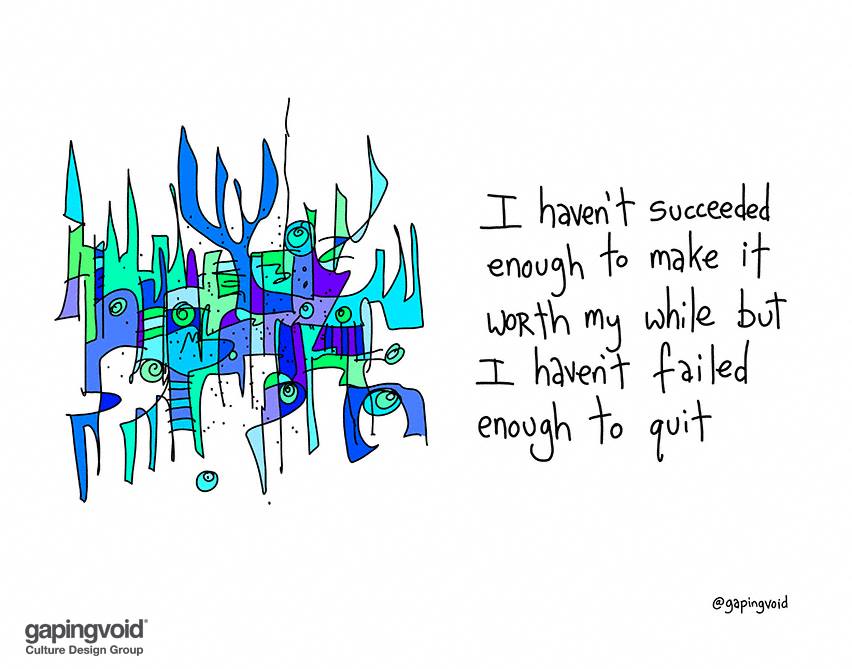
Illustration: gapingvoid
Idea Champions
Posted by Mitch Ditkoff at 10:39 PM | Comments (0)
May 04, 2017Need a Breakthough? Unplug for a Moment. Take a Break!

True innovators rarely follow the straight and narrow path. Not only do they march to a different drummer, they're often not even on the same playing field as most people. Take Seymour Cray, for example, the legendary designer of high-speed computers.
According to John Rollwagen, ex-chairman of Cray research, Seymour used to divide his time between building the next generation super computer and digging an underground tunnel below his Chippewa Falls house.
Cray's explanation of his tunnel digging behavior is consistent with the stories of many other creatives -- inner-directed, boundary-pushing people who understand the need to go off-line whenever they get stuck.
Bottom line, whenever they find themselves struggling with a thorny problem, they walk away from it for a while. They know, from years of practical experience, that more (i.e. obsession, analysis, effort) is often less (i.e ideas, solutions, results).
Explained Cray, "I work for three hours and then get stumped. So I quit and go to work in the tunnel. It takes me an hour or so to dig four inches and put in the boards. You see, I'm up in the Wisconsin woods, and there are elves in the woods. So when they see me leave, they come back into my office and solve all the problems I'm having. Then I go up (to my lab) and work some more."
Explained Rollwagen, "The real work happens when Seymour is in the tunnel."
We help people dig their tunnel
And sometimes we do this via storytelling (like the one above)
MitchDitkoff.com
Posted by Mitch Ditkoff at 09:55 PM | Comments (0)
April 21, 2017Move the Hole!

I like what Edward deBono once said about the phenomenon of creative people trying to get results, but coming up empty (and I paraphrase). "If you are digging for oil and don't find any, move the hole!"
Pretty simple, eh? Sometimes, it seems as if aspiring innovators get fixated on a particular approach and, no matter what happens (or doesn't), they just keep doing the same old thing over and over again even when experience reveals that their approach is not working.
Of course, it's always possible that other factors are at play:
1. Perhaps the hole you've dug is too shallow and success is only a few shovelfuls away. Digger deeper, then, makes sense. Always possible.

2. Maybe you're digging in the right place, but the tools you're digging with are not the right tools for the job.
3. And, of course, it's always possible that in your effort to discover oil, you don't see the unexpected diamonds and gold coins you stumble upon because everything that is "not oil" is invisible to you.
So, let's make this real for a moment. Think of a project you are working on -- one you have passion for whose results have been slower to materialize than you hoped. Got it? Good. Now answer the following before doing any more digging:
CAN YOU DIG THIS?
1. What are your instincts telling you about how to proceed? Have you dug the hole deep enough? Might it be time for you to move the hole? And if it is the time to move the hole, where might you move it? What are some new approaches to try? Other places to look?
2. If you sense that you haven't dug deep enough -- that you've been a dilettante, slacker, or half-hearted digger for oil -- what can you do to martial your forces and commit to a more rigorous digging effort? And what support, if any, might you need?
3. If, in your digging adventures, you have stumbled upon some unexpected "finds", but dismissed them because you were only focused on oil, how might you extract the value from your accidental discoveries?
By the way, 75% of all product breakthroughs are NOT the result of strategic plans or "intentional effort", but the result of serendipity and "happy accidents" -- what happens when the open-minded innovator stumbles on something intriguing, pauses, and makes the right kind of effort to see if this discovery has value and is worth pursuing.
Posted by Mitch Ditkoff at 02:07 PM | Comments (0)
March 24, 2017Free Online Innovation and Creativity Summit 2017
Here's Nick Skillicorn introducing the upcoming, online Innovation and Creativity Summit 2017. I am happy to announce that I will be one of the 45 presenters. My topic? The power of storytelling to spark innovation. Cost? Zero. Zippo. Zilch. Click here to register. Summit begins on April 2.
MitchDitkoff.com
Storytelling at Work
Posted by Mitch Ditkoff at 10:53 AM | Comments (0)
March 10, 2017Making the Time to Be Creative
One of the biggest obstacles to creativity and, by extension, innovation, is the lack of time that is so prevalent in today's ADD culture. This two-minute video makes a very compelling case for you and all the people you work with to take some more time if you REALLY want to crank up the creativity.
25 quotes on creativity
Idea Champions
Posted by Mitch Ditkoff at 09:26 AM | Comments (0)
March 07, 2017Innovation Begins with Fascination

I own a huge library of books on innovation. Mostly hardcover. The $27.95 variety with big indexes and forwards by people who make more money than I do. Some of these books are actually good. Most of them bore me. (I must confess I have a secret desire, whenever I enter a bookstore, to put glue between pages 187 & 188 in all of the new releases just to see if the publishers get any complaints).
The books attempt to describe the origins of innovation. You know, stuff like "the innate human impulse to find a better way" and "the imperative to find a competitive edge." That sort of thing.
Corporate-speak, in other words.
In my experience, the origin of innovation is fascination -- the state of being intensely interested in something. Enchanted. Captivated. Spellbound. Absorbed. What kids are naturally good at.
Kids and those mavericks at workwho make everyone nervous and running for their spreadsheets at the drop of a hat.A person who is fascinated does not need to be motivated... or managed... or "incentivized."
All that person needs is time, some resources, meaningful collaboration, and periodic reality checks from someone who understands what fascination is all about.
That's why Google gives its workforce 20% of their time to explore projects on their own. That's why 3M and W.L. Gore do something similar. They know that the root of innovation is fascination.
If you, or the people who report to you, are not currently in a state of fascination it's time to turn things around. That is, IF you want to spark some innovation.
How do you do this? For starters, try this simple exercise:
THE SEED OF FASCINATION
1. On a piece of paper, create three parallel headlines -- "What Fascinates Me," "People I Admire," and "What I Would Do If I Knew I Couldn't Fail."
2. Jot down at least five responses beneath each headline.
3. Look for intriguing, new connections between your responses. Any insights? Ahas?
4. Jot down your new ideas.
5. Circle your favorite idea and brainstorm it with a friend. Then pitch anyone who's influence can help you launchyour ideas for how to bring more fascinating projects into your work life.
Posted by Mitch Ditkoff at 11:24 PM | Comments (7)
June 07, 2016HOW TO GET PEOPLE OUT OF THE BOX: A 5-Minute Tutorial

Ever heard the expression "get out of the box?" Of course you have. Ever wonder what the six sides of that so-called box actually are? If not, here's your 5-minute tutorial of the day. Once you're clear about what the sides of the box are, you will be significantly more able to help people (and yourself) get out of it.
One way to get out of the box
Another way
My book on the subject
Boxes
Posted by Mitch Ditkoff at 11:24 AM | Comments (0)
May 06, 2016A Very Cool Brainstorm Facilitation Training for People in the Fast Lane
Our brainstorm website
More about the training
What our clients say
Tell us more about your need
Our client list
VIDEO: The eight dimensions of a brainstorming session
Posted by Mitch Ditkoff at 12:49 PM | Comments (0)
February 16, 2016An Innovation in Climbing, Art and Helping At-Risk Communities

Jon Sedor realized, as a high school sophomore, that his passion in life was all about rock climbing and painting. However, in 2007 Jon lost his left (dominant) hand in a serious accident. Two amputations three surgeries, and lots of challenges later, Jon had still not given up his dreams. He could have easily submitted to what seemed to be a limitation, but he didn't. No way.
Since his accident, Jon has relearned to draw as a right-handed person, graduated from the School of Visual Arts with his MFA in 2014, and has become a nationally and internationally ranked rock climber. But Jon has a much grander vision than simply being a world class climber and working artist.
He wants to give back to the various communities that have given him so much meaning and healing in his life. And he wants to do so by helping other athletes with physical differences push their limits and achieve their own seemingly impossible goals.

Towards that end, Jon and some very committed friends have joined together to create the Pebble Wrestler Collective -- an adventure film and creative apparel company based in Cleveland, Ohio. Their goal is to showcase the unique individuals and opportunities within the athletic and artistic lifestyles they pursue.
The Collective is comprised of outdoor adventurers -- from climbers and surfers, to skiers and snowboarders. Not only are they athletes, they are artists, film makers, and philanthropists, too. Bottom line, they are using their love of adventure and the visual arts to build awareness of the challenges and accomplishments of adaptive athletes, as well as helping communities by providing at-risk youth with healthy alternatives to street life -- climbing, surfing, and snowboarding.
Jon and the Pebble Wrestler collective have launched a Kickstarter Campaign is to fund their efforts. They are halfway to their goal of raising $18,000 and have until March 2nd to raise the rest.
Which is precisely why the Heart of Innovation has posted this update. We are calling on all our readers to pitch in -- even if it's just $10. It's easy to talk about innovation. It's easy to write about innovation. But in the end, when push comes to shove, action is what's needed -- crowd sourced, inspired, collaborative, dig deep, go-beyond-the-obstacles action. You in?
Thanks, in advance, for any support you can provide. Today is Jon's day to ask the world community for support. Tomorrow might be yours.
Click here to donate
More about the Pebble Wrestler Collective
JonSedor.com
Posted by Mitch Ditkoff at 09:51 AM | Comments (0)
January 26, 2016Story as a Leadership Tool
Here's a lovely animated intro to why STORYTELLING is such a powerful communication and business tool -- by the author of Circle of the 9 Muses.
Storytelling at Work
More useful links about storytelling
And more
Posted by Mitch Ditkoff at 06:44 PM | Comments (0)
September 15, 2015The Art of Sparking Innovation
When my mother was alive, she told me she had no idea what I did for a living. Around the canasta table, she would tell her friends I was a "motivational speaker", no matter how many times I explained what I actually did. The slide show below is dedicated to her and to YOU, too -- especially if you're wondering what the heck goes on in one of Idea Champions' innovation-sparking workshops. Best to view full screen.
Posted by Mitch Ditkoff at 05:18 PM | Comments (0)
September 04, 2015HOW TO MAXIMIZE IDEA POWER FOR FREE: A 3-Minute Video Tutorial

Need powerful, new ideas to grow your business, solve a problem, or find a better way? Don't want to go to yet another meeting to figure things out? Start paying attention to the ideas you are conceiving away from the workplace. And encourage others to do so, as well. Here's WHY and HOW.
Idea Champions
First, identify the problem
Innovation sparking keynotes
Free online creative thinking tool
Posted by Mitch Ditkoff at 10:34 AM | Comments (0)
August 10, 2015Innovation & Poetry Are Connected
PS: There is something poetic about innovation. And there is something innovative about poetry. When I'm not working with organizations to spark innovation, I'm writing poetry. Click here to order my book.
Posted by Mitch Ditkoff at 12:07 PM | Comments (0)
July 17, 201550 Rules of Innovation
Nice slideshow. Other than the word "rules" in the title, this is an inspiring guide to what aspiring innovators need to be mindful of.
Posted by Mitch Ditkoff at 09:34 AM | Comments (0)
June 09, 2015The Idiot Savant's Guide to Jump Starting Creativity and Innovation

If you are looking for a simple, inexpensive way to jump start innovation and creativity -- in yourself, your team, or your company, click here. Idea Champions' Innovation Kits are easy to use, easy to buy, and fully engage movers and shakers in the process of conjuring up (and manifesting) bold, new possibilities.
Idea Champions
What our clients say
Posted by Mitch Ditkoff at 12:43 PM | Comments (0)
May 01, 2015The Professor and the Jar

A college professor stood before his philosophy class at the start of a new semester. Silently, he picked up a very large jar and filled it with golf balls. Then he asked the students if the jar was full. They agreed that it was.
The professor then picked up a box of pebbles and poured them into the jar. He shook the jar lightly, pebbles settling into the open areas between the golf balls. He then asked the students again if the jar was full.
They agreed that it was.
The professor next picked up a box of sand and poured it into the jar. He asked once more if the jar was full. The students again responded with a resounding "yes."
The professor then produced two cups of tea from under the table and poured them into the jar, filling the empty spaces between the sand. The students laughed.
"Now," said the professor. "I want you to understand that this jar represents your life. The golf balls are the important things -- your family, health, friends, and feeling of well-being. If everything else was lost and only they remained, your life would still be full."
"The pebbles are the other things that matter -- your job, your house, your accomplishments etc. The sand is everything else -- the small stuff."
"If you put the sand into the jar first," he continued, "there's no room left for the golf balls or pebbles. The same holds true for life. If you spend all your time and energy on the small stuff, you'll never have room for the things that are really important to you."
"Pay attention to the things that are essential to your happiness. Spend time with your children. Spend time with your parents. Take your spouse out to dinner. Smell the flowers. Enjoy the beauty of existence. There will always be time to clean the house and fix the disposal. Take care of the golf balls first -- the things that really matter. The rest is just sand."
One of the students then raised her hand and asked what the two cups of tea were about
The professor smiled, "I'm glad you asked."
"The tea shows you that, no matter how full your life may seem, there's always room for tea with a friend."
This story is not in my forthcoming book, but 36 others are.
Idea Champions
Posted by Mitch Ditkoff at 09:36 AM | Comments (1)
February 22, 2015GUY WIRE: The Art of Innovation
Here is a no BS, engaging, entertaining, honorable 21-minute talk on innovation, by the extremely refreshing Guy Kawasaki. Many pearls of wisdom in this and some good jokes.
Posted by Mitch Ditkoff at 05:33 PM | Comments (0)
February 17, 2015On Being an Idea Champion

There's a reason why the expression "ideas are a dime a dozen" is so popular. Because they are. It's easy to get ideas. What's not so easy is championing ideas. And by "championing", I am referring to the kind of heroic commitment required to actually manifest those ideas. Here's my six-minute video elaboration on this often neglected topic. It's great that you have a new idea you care about. Wonderful. Now, ask yourself "What is it going to take for me to press through all the inevitable obstacles and bring this idea to life?"
Posted by Mitch Ditkoff at 07:34 AM | Comments (0)
January 24, 2015Radio Woodstock in the House!

We just received this very nice piece of feedback from the President of Radio Woodstock, Gary Chetkof.
"Idea Champions was a true partner in helping us untangle some of the issues we were struggling with. They were very easy to work with and the processes used were fun and creative and they worked splendidly. We were able to find out what the major obstacles were and our entire team worked together to find solutions. Everyone participated fully, and everyone now has much more clarity about how to better work together. We even have our new mission statement that you can see on our Facebook page! I wholeheartedly recommend Idea Champions to any business that wants to problem solve, brainstorm, or get their employees to work more harmoniously together."
Our teambuilding offerings
Yes, Idea Champions is based in Woodstock!
And this just in from Richard Fusco, Radio Woodstock's General Manager:
"As a small company where everyone wears many hats, being organized and all pulling in the same direction is key. Strangely, as a communications company, our internal communications were off. Val Vadeboncoeur of Idea Champions helped us with all three. His sessions were focused and fun. We all came away with a new unified working spirit."
Posted by Mitch Ditkoff at 11:34 AM | Comments (0)
January 08, 2015VIDEO: Ideas Are Scary
50 quotes on the power of ideas
Let us scare you
Scare yourselves
That big beautiful idea of yours
Posted by Mitch Ditkoff at 04:10 PM | Comments (0)
December 23, 2014The 25 Most Influential Innovation Blogs and Experts: 2014
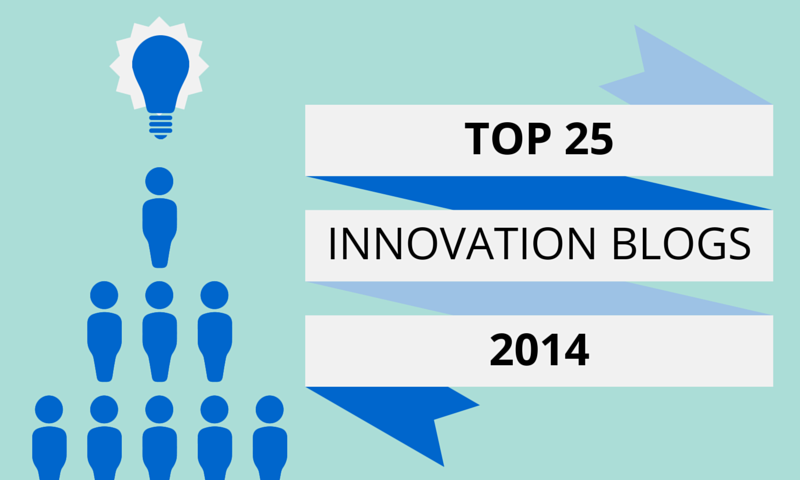
GOOD NEWS! Idea Champions' The Heart of Innovation blog was just chosen as one of the top 25 "innovation blogs and experts" of 2014 (just 86 years after the first American Yo Yo factory opened in California). Check it out here. To be more specific, The Heart of Innovation is listed as #20. So, it's officially official: You are not a loser for reading this blog. On the contrary, you are insightful, intelligent, adventurous, creative, and very good looking, if not just a wee bit twisted. PS: There are a number of other, fine innovation blogs noted on Nick Skillicorn's end-of-the-year-round-up. Worth a look.
Posted by Mitch Ditkoff at 11:04 PM | Comments (2)
December 13, 2014BIG IDEA: Empowering the Homeless
What idea do you have to make a difference? What can YOU do to go beyond the obvious and really be of service to people in need? And if you work in an organization, how can you rally the troops to join you in the venture? Check out what 24-year old Veronika did. Genius!
Need to brainstorm it with others?
Just need a starter idea?
Posted by Mitch Ditkoff at 07:46 PM | Comments (0)
December 06, 2014Who We Are and What We Do

When my mother was alive, she would ask me, at regular intervals, what I did for a living. I would do my best to explain it to her but, somehow, her explanations to her friends around the canasta table always ended up with some version of "my son is a motivational speaker." No matter how hard I tried to educate dear Sylvia about what I REALLY did, nothing stuck. It would have been easy if I was a doctor, lawyer, or dentist, but I wasn't. I was a....
Anyway, a few days ago, a new prospect of Idea Champions just asked me a similar question. This is what I told her:
Idea Champions is an innovation consulting and training company, headquartered in Woodstock, NY. Since 1987, we have been helping a wide variety of forward thinking organizations increase their employee's ability and commitment to think creativity, generate powerful new, business-growth ideas, collaborate, and develop the kind of organizational culture that is conducive to sustainable innovation.

How we accomplish this noble goal depends on the current reality of each client, their level of commitment, and what their hoped-for outcomes are.
Services we provide include: innovation-sparking keynotes, leadership development sessions, creative thinking training, facilitated brainstorming sessions, culture of innovation workshops, brainstorm facilitation training, team building, executive coaching, and innovation-sparking materials.
Our clients have included: General Electric, AT&T, Merck, Lucent Technologies, NBC Universal, Pfizer, Kraft Foods, General Mills, MTV Networks, Chubb insurance, Goodyear Tire, Citibank, Wells Fargo, TV Guide, Hitachi, A&E Television, Genentech, Michelin, Con Edison, MBooth, Blue States Digital, Duke Corporate Education, Atlanticare, TIAA Cref, The National Institutes of Health, Champion International, Coca Cola, and a host of others. This is what they say about us.
Intrigued? Check out either or both of our websites:
Idea Champions
Brainstorm Champions
Posted by Mitch Ditkoff at 02:53 PM | Comments (0)
October 09, 2014Playing With Parkinson's

Q. What do Muhammed Ali, Billy Graham, Roger Bannister, Steve Allen, Linda Ronstadt, Michael J. Fox, and Robin Williams all have in common?
A. Each of them have inspired and delighted millions of people. And each of them have had to deal with Parkinson's disease, a degenerative disorder of the central nervous system that affects approximately 7-10 million people worldwide.
With the recent passing of Robin Williams, the world has gotten yet another opportunity to learn about the ravages of this little-understood disease, named after James Parkinson, an English physician who published the first detailed description of it back in 1817.
But no matter how many news articles, tweets, fundraisers, or newly-detected sufferers of this disease come to light, most of us have very little visceral understanding of what Parkinson's is and how it deeply affects those who lives are turned upside down by its progressive debilitation.
Until now, that is -- with the imminent release, at the Woodstock Film Festival, of Burrill Crohn's groundbreaking documentary, Playing With Parkinson's -- the soul-stirring story of Sangeeta Michael Berardi.

Sangeeta may not be a household name like the other luminaries noted above, but after Crohn's film makes the rounds, he very well may be. A consummate musician, Sangeeta (whose name translates as "Divine Song") has enjoyed, since the 1960s, a successful career as a jazz guitarist and has played with such greats as Archie Shepp, Roswell Rudd, Pharoah Sanders, Alice Coltrane, Karl Berger, and Rashied Ali. But in 2001, "Mr. P" (as Sangeeta playfully refers to Parkinson's) came knocking at his door.
The subsequent tremors and shakes -- the most visible signs of the disease -- not only made playing the guitar increasingly difficult, but also the simplest of daily tasks -- like drinking a glass of water... or picking up the phone.... or walking into the next room.
True to his jazz roots, however, Sangeeta, "went with the moment," adapting and adjusting to the new song that life -- his life -- was demanding he play. A lesser man might have abandoned music, but not Sangeeta. Reaching deep within himself, he found a way to turn what others term "disability" into an astounding new ability -- the ability to find beauty, meaning, and self-expression in the present moment, no matter what limitations were thrust upon him.
Simply put, Sangeeta created new ways to make music -- using breakfast bowls, tabletops, found objects, his omnipresent bag of pills, and his Parkinson's-compromised voice. Necessity wasn't only the mother of invention for Sangeeta, it was also the father, cousin, uncle, grandmother, and sound engineer, too.
Previewing Playing with Parkinson's in Burrill Crohn's Woodstock studio two weeks ago, I found myself crying and shaking -- stunned by Sangeeta's indomitable spirit of creativity and the filmmaker's extraordinary ability to communicate the highest attributes of what it truly means to be a human being.
Also published in the Huffington Post
More about Burrill Crohn
Burrill Crohn on LinkedIn
Posted by Mitch Ditkoff at 06:01 AM | Comments (0)
October 07, 2014THE SEED OF INNOVATION MOMENT: A 3-Minute Video Tutorial

If you are trying to spark a renaissance of innovation in your company by launching some kind of "innovation initiative", consider the fact that the seed of innovation is already available in every conversation that people are having. This 3-minute video tutorial dives in deeper.
The Seed of Innovation keynote
Create change agents
A more structured way to do this
Posted by Mitch Ditkoff at 03:51 PM | Comments (0)
September 19, 201426 Inspired Quotes on the Innovation Most Needed on Planet Earth -- PEACE!
You've heard of product innovation, process innovation, business model innovation, and disruptive innovation. Now it's time for PEACE INNOVATION -- and that's what's happening on September 21st all around the world as millions of people in cities, towns, and hamlets gather together to celebrate the International Day of Peace.
Want to know more? See more? Feel more? Tune into PeaceCast, a 48-hour livestream broadcast to celebrate the International Day of Peace. Starts at 8:00 am (EDT) on 9/20 and ends at 6:00 am (EDT) on 9/22.
Posted by Mitch Ditkoff at 11:36 PM | Comments (0)
September 15, 2014Is Peace the Innovation We Need the Most?

"Innovation" continues to be a hot topic in corporate circles these days -- a "competitive edge" organizations are increasingly attempting to hone so they can not only differentiate themselves from the competition, but survive in today's topsy turvy economy.
That being said, there are some forward thinking organizations out there who are going beyond the status quo and seriously asking themselves what they can do differently to not only be "socially responsible", but use their corporate clout to help various peace-themed global causes truly impact positive change.
If that describes your organization, please contact us. Idea Champions, in 2015, will be launching a new innovation-sparking service to help corporations, world wide, figure out HOW they can leverage their resources, bandwidth, and brainpower to foster peace and well-being in the world -- and still make a profit.
International Day of Peace in the Huffington Post
Idea Champions
Posted by Mitch Ditkoff at 02:35 PM | Comments (0)
August 20, 2014How Many Dancers Does It Take to Screw in a Lightbulb?

Here is
the answer
to a question
you probably
never asked before
because
the answer
seemed
too difficult
to figure out
(or you were at a meeting).
How many dancers
does it take
to screw in
a light bulb?
If you want your brainstorm sessions to be more like dancing than having everyone's feet nailed to the floor, click here.
Posted by Mitch Ditkoff at 05:48 PM | Comments (0)
August 02, 2014Unleashing Business Brilliance

That's what we do. And below are five ways we do it.
Conducting Genius
Engaging Innovation
Ingenious Leadership
What's the Problem?
Team Innovation
What our clients say
Posted by Mitch Ditkoff at 05:00 PM | Comments (0)
April 02, 2014Zen Innovation Koan of the Day
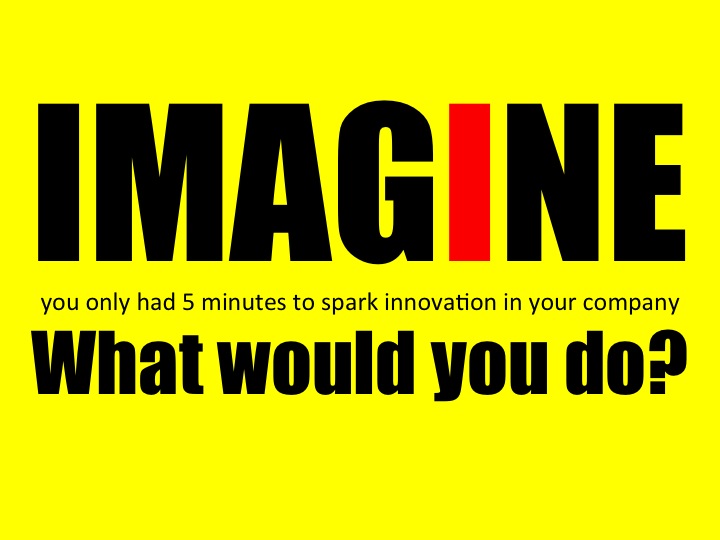
Posted by Mitch Ditkoff at 08:35 PM | Comments (0)
March 29, 201456 Reasons Why Most Corporate Innovation Initiatives Fail

Innovation is in these days. The word is on the lips of every CEO, CFO, CIO, and anyone else with a three-letter acronym after their name. As a result, many organizations are launching all kinds of "innovation initiatives" -- hoping to stir the creative soup. This is commendable. But it is also, all too often, a disappointing experience.
Innovation initiatives sound good, but usually don't live up to expectations. The reasons are many. What follows are 56 of the most common -- organizational obstacles we've observed that get in the way of a company truly raising the bar for innovation.
See which ones are familiar to YOU. Then, sit down with your Senior Team... CEO... innovation committee, or team and jump start the process of going beyond these obstacles.
56 Reasons Why Most Corporate Innovation Initiatives Fail
1. "Innovation" framed as an initiative, not the normal way of doing business
2. Absence of a clear definition of what "innovation" really means
3. Innovation not linked to company's existing vision or strategy
4. No sense of urgency
5. Workforce is suffering from "initiative fatigue"
6. CEO does not fully embrace the effort
7. No compelling vision or reason to innovate
8. Senior Team not aligned
9. Key players don't have the time to focus on innovation
10.Innovation champions are not empowered
11. Decision making processes are non-existent or fuzzy
12. Lack of trust
13. Risk averse culture
14. Overemphasis on cost cutting or incremental improvement
15. Workforce ruled by past assumptions and old mental models
16. No process in place for funding new projects
17. Not enough pilot programs in motion
18. Senior Team not walking the talk
19. No company-wide process for managing ideas
20. Too many turf wars. Too many silos.
21. Analysis paralysis
22. Reluctance to cannibalize existing products and services
23. NIH (not invented here) syndrome
24. Funky channels of communication
25. No intrinsic motivation to innovate
26. Unclear gates for evaluating progress
27. Mind numbing bureaucracy
28. Unclear idea pitching processes
29. Lack of clearly defined innovation metrics
30. No accountability for results
31. No way to celebrate quick wins
32. Poorly facilitated meetings
33. No training to unleash individual or team creativity
34. Voo doo evaluation of ideas
35. Inadequate sharing of best practices
36. Lack of teamwork and collaboration
37. Unclear strategy for sustaining the effort
38. Innovation Teams meet too infrequently
39. Middle managers not on board
40. Ineffective roll out of the effort to the workforce
41. Lack of tools and techniques to help people generate new ideas
42. Innovation initiative perceived as another "flavor of the month"
43. Individuals don't understand how to be a part of the effort
44. Diverse inputs or conflicting opinions not honored
45. Imbalance of left-brain and right brain thinking
46. Low morale
47. Over-reliance on technology
48. Failure to secure sustained funding
49. Unrealistic time frames
50. Failure to consider issues associated with scaling up
51. Inability to attract talent to risky new ventures
52. Failure to consider commercialization issues
53. No rewards or recognition program in place
54. No processes in place to get fast feedback
55. Inadequate sense of what your customers really want or need
56. Company hiring process screens out potential innovators
Posted by Mitch Ditkoff at 01:31 PM | Comments (4)
That Big Beautiful Idea of Yours
What big, beautiful idea of yours needs just the right touch of collaboration, support, and immersion to see the light of day? Your next step? And when will you take it?
One way to get rolling
Brainstorm facilitation training
Idea Champions
Posted by Mitch Ditkoff at 10:00 AM | Comments (0)
March 16, 2014How to Spark Wisdom in the Workplace
Dear Heart of Innovation Readers:
If you have received any value from this blog and would be interested in supporting my next, big project -- now launched as a GoFundMe campaign -- click here for a 3-minute video of me describing it and a written description of what the whole thing is all about -- a venture which includes the writing, publication, and promotion of a new book, Wisdom at Work, along with the launching of WISDOM CIRCLES in organizations around the world.
Whatever support you can provide is very much appreciated, Plus, you will be sent a copy of the book when it's published, if you want.
Mitch Ditkoff's GoFundMe campaign
Posted by Mitch Ditkoff at 09:35 AM | Comments (0)
February 19, 2014How to Open the Door to Innovation

There is no magic pill, but there is a key. And the key has a lot to do with creating a critical mass of savvy innovation catalysts and change agents who know how to open doors (and minds).
Posted by Mitch Ditkoff at 08:32 PM | Comments (0)
February 17, 2014Would You Invest Three Hours to Save Yourself Months of Wasted Effort?

Idea Champions has just launched a groundbreaking three-hour workshop that will save your organization untold time, tons of money, and a thousand pounding headaches you can't afford to have.
Posted by Mitch Ditkoff at 02:18 PM | Comments (0)
February 15, 2014How to Help Your Senior Team Get Aligned About a Strategic Direction

I am totally inspired by the feedback that Steven McHugh, co-Founder and Chief Innovation Officer of Idea Champions, received from Life Care Centers of America, in response to a two-day Senior Team Strategy Offsite he designed and facilitated for them. See below...
 "I wanted to thank you for the wonderful work you've done for us at Life Care Centers of America.
"I wanted to thank you for the wonderful work you've done for us at Life Care Centers of America.
As you know, when I left my CFO position at Olin Corporation to help lead Life Care, I was presented with a number of difficult challenges. Due to strict government regulations, the long-term care industry was in turmoil. In 30 years, Life Care had not performed any unified, long-term strategic planning, and there was no HR department for over 27,000 employees.
Based on the excellent work you did for over five years with my former company, I knew you had the skills to help us. Your role in aligning 230 different facilities into a unified force has been remarkable, especially in the short time frame you were given.
As you know, the results of the process you took us through have been astounding. In an environment where five of the top six public nursing home companies have declared bankruptcy, we have enjoyed unprecedented growth. You helped our senior officers transform into a dynamic leadership team. Our clarity around an aligned mission translated into a powerful vision that we can communicate to the rest of the organization.
Your Vision Mapping sessions were the catalysts for communicating our message to the rest of the organization. Your ability to develop balanced scorecards for all 230 facilities was the key to translating strategy into results.
It is now clear what actions are important for us to take, and for the first time, our people know how their success will be measured.
From the senior level to the staff in each facility, actions are now aligned to achieve strategic goals.

As an interesting byproduct of your work here, we are beginning to develop leaders at all levels in the organization who are empowered to do whatever it takes to get the job done. They have a clear line of sight to the strategic goals and are stepping up to the plate to get them done.
I am proud of how we have responded to the process you have embedded into our culture. Thank you for justifying my faith in bringing you in to facilitate this major change in how we operate.
I look forward to continuing our work together in developing a high performance organization."
-- Michael Waddell, President, Life Care Centers of America
50 quotes on possibility
50 quotes on vision
Creators on Creating
What we do
Idea Champions
Posted by Mitch Ditkoff at 01:26 PM | Comments (0)
January 03, 2014Innovation in Loving Our Fathers
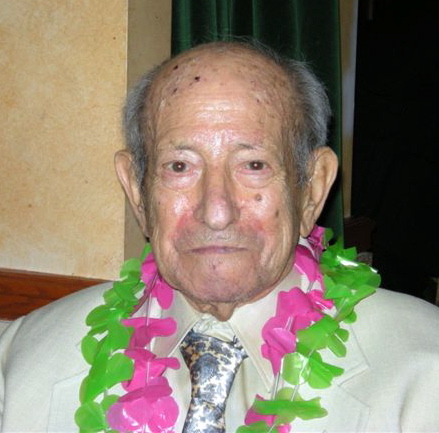
If you're reading this, there's a good chance you are involved in some kind of effort to innovate and get out of the so-called box. But there's also a good chance you have a father -- living or not. In either case, you might find this just published article of mine, in the Huffington Post, timely -- written just one day after my own father passed away in 2009. It will take you less than four minutes to read, but may tap into some timeless feelings.
Posted by Mitch Ditkoff at 05:05 PM | Comments (0)
September 27, 2013It All Began With Balls

Most companies begin on a shoe-string -- under-funded, under the gun, and under the radar. The company I co-founded in 1986, Idea Champions, was no exception.
When my business partner and I began, we had almost nothing -- just an idea, some chutzpah, and a deep desire to succeed.
While we both were likable, smart, and skillful schmoozers, we had zippo in the way of a marketing plan.
Racking what was left of our over-caffeinated brains, it soon became abundantly clear that we needed some kind of showcase, some kind of "window to the world" -- a place to strut our entrepreneurial stuff and get in front of the people who were the likely buyers of our service...
Back in those days, this meant one thing -- renting a booth at the ASTD convention -- the annual meet market in the training and development field.
The thought of this made the two of us slightly nauseous, since we had "cased the joint" a year before and come away with three impressions:
1. We didn't have enough money to get in the door
2. We didn't have the right marketing materials
3. We probably should have gone into our father's business.

Clearly, we'd have to do something different if we were going to distinguish ourselves from the 600 other companies vying for the same customers.
Giving out slick brochures was out of the question. (We didn't have any). Giving out our client list was also out of the question. (You could count the number of our clients on one hand -- the hand of Vinny "Three Finger" Scalucci).
In a flash of entrepreneurial mania, it became obvious that we would need a lot of balls to pull this off. Yes, the kind you're thinking of, but also another kind -- juggling balls.
The AHA? We'd create an "anti-booth" and teach people how to juggle. Our booth would be a rest stop, a haven, a place for thousands of convention-weary people to recuperate from all the other booths with their endless supply of Hershey's kisses, business jargon, and fishbowls full of business cards.
OK. So we didn't have a marketing plan, but we did have inspiration. And even more than that, a very specific idea of how to get the attention of the marketplace.
Our plan was simple.
We'd bring a posse of our juggling-savvy friends and teach thousands of convention-goers how to do something they'd secretly wanted to learn for years -- juggle. No hard sell. No corporate speak. No used-car salesman smiles -- just the experience of having a breakthrough.
And our message would be delivered in 30 seconds or less.
Here's how it worked: As aspiring jugglers dropped their balls, we'd drop in a few well-timed comments to help them make the link between what it took to learn to juggle and what it took to innovate.
Our booth was wildly popular. People loved it. People loved us. And we always had a crowd.
But "having a crowd" doesn't necessarily translate into sales -- and sales is what we were after. Were we pumped? Yes. Were we optimistic? That, too. But still we had nothing to show for our efforts.
That is, until the afternoon of the third day.
That's when we spied the proverbial big fish walking in our direction. DIRECTOR OF TRAINING & DEVELOPMENT, AT&T his name tag screamed.
This was the moment -- the moment of truth.
The impeccably dressed Mr. Big approached. He stopped, tried to look through me, and spoke:
"What's this?" he asked.
"Um.... what does it look like?" I replied.
"Juggling?" he responded.
"That's right!" I said. "Would you like to learn?"
Ah.... the existential moment of truth! Dare he lay down his plastic bags of information to try something new? Dare he stop being in charge and become a student for a change? Dare he run the risk of failing.
He looked at me. I looked at him. Then he cleared his throat.
"I've been trying to learn to juggle for 25 years," he confessed, looking at his watch. "OK. Teach me... but... all I have is five minutes."
By the grace of the juggling Gods, we taught the man. In five minutes. His mind was blown. Borderline ecstatic, he reached into his wallet and pulled out a business card.
"I don't know what you guys do," he laughed, "but I know you're not a juggling company. Call me on Monday and let's talk."
We did. He took our call -- and spent the next 20 minutes telling us about his weekend juggling adventures. How he couldn't stop. How he taught his son. How he had a ton of fun.
Then he started grilling us about our work. Apparently, he liked what he heard, because the next thing we know he's inviting us to pilot our creative thinking training at AT&T.
Which we did.
The training was a big hit -- so much so, that our now juggling-savvy client invited us back two more times the next month to do it again, (just to make sure the glowing feedback wasn't a "false positive.")
It wasn't.
Those sessions were also a success. So much so, that Mr. New-Juggler-After-25-Years-of-Frustration pulled the corporate trigger and licensed our training.
During the next three months we taught nine AT&T trainers how to facilitate it. Then, when Lucent split off from AT&T, we taught their trainers and enjoyed five years of great results and even greater passive income.
How did it all begin?
By doing something different. By going with our strengths. By differentiating ourselves from the competition. By translating theory into practice. By giving people an experience, not just words. By skillfully responding to a moment of truth. By having fun. And...by translating all of the above into a service that delivered on it's promise.
Balls got us started, but it was execution that sealed the deal.
FOOD FOR THOUGHT:
1. What risk are you willing to take to grow your business?
2. What strengths of yours do you need to leverage?
3. What moment of truth is fast approaching for you?
The above story is excerpted from STORYTELLING AT WORK: How Moments of Truth on the Job Reveal the Real Business of Life.
Idea Champions
The training we licensed to AT&T
My first book
"If not you, who? If not now, when?"
Posted by Mitch Ditkoff at 04:57 AM | Comments (5)
March 20, 2013How to Humanize the Workplace
A recent poll has revealed that 62% of Americans are dissatisified with their work.
While there are a lot of contributing factors, one BIG factor is that most workplace environments are not wired to bring out the best in people. Quite the contrary.
That's what my newly published article in the Huffington Post is all about.
It doesn't just name the problem, however. It also provides a simple "starter kit" for how each and everyone of us can begin to humanize our workplace environments.
Click here to weigh in on the topic by responding to my Humanizing the Workplace poll. If you want to register for my April 4th Telesummit on this topic, click here. It's free.
Idea Champions
Posted by Mitch Ditkoff at 12:32 PM | Comments (0)
February 10, 2013What Our Clients Say About Us
Posted by Mitch Ditkoff at 12:46 AM | Comments (0)
December 13, 2012What's Next After Twitter
This just in! Twitter is dead.
Or if not dead, dying. Or if not dying, passe. It's time has come and gone.
Industry experts agree. There is now a way more streamlined option available to you. Find out here -- noted in my most recent Huffington Post article.
12/12 is the Pope's first day on Twitter.
Idea Champions
Posted by Mitch Ditkoff at 12:07 PM | Comments (0)
November 19, 2012Layne Redmond's Kickstarter Project
Here is a link
to a very inspired Kickstarter project
originated by my good friend,
Layne Redmond,
author of
When the Women Were Drummers
and all around renaissance women.
Layne and her team
of talented musicians
and film makers
are making a documentary
celebrating the dance,
drumming, and chants
of traditional and sacred
Brazilian culture.
Click here to donate.
Posted by Mitch Ditkoff at 10:19 AM | Comments (0)
November 16, 2012VOTE FOR ME (I will not raise taxes, start a war, or give a boring speech)

Good news! A leading Speaker's Bureau has just nominated me as a TOP FIVE SPEAKER in the field of innovation & creativity. To win, I need your vote.
So... if you believe I've added value to this field and am speaking about it in a way that inspires and educates, I humbly ask for your vote.
All you need to do is click this link , then scroll down to the fifth category and check the box next to my name (MITCHELL DITKOFF). Then scroll to the bottom and enter your name etc. The whole thing will take you less than three minutes.
My ten tips for giving a great keynote.
Posted by Mitch Ditkoff at 12:12 AM | Comments (0)
August 26, 2012Savvy Book Agent Wanted
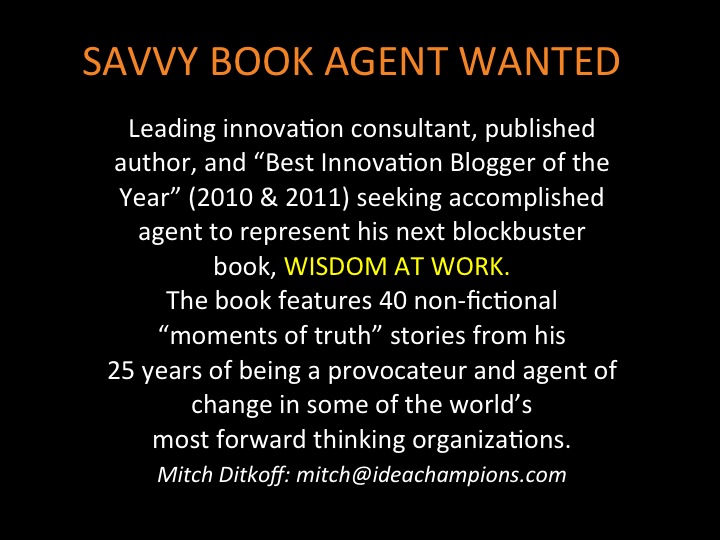
That's me, folks, the author of this blog. Any recommendations?
Posted by Mitch Ditkoff at 11:30 AM | Comments (0)
August 10, 2012Web Workshops from Idea Champions
Here's a 3minute video overview of Idea Champions newest service -- Web Workshops -- highly engaging 60-minute tutorials to help your workforce raise the bar for innovation, collaboration, and communication.
Posted by Mitch Ditkoff at 04:11 PM | Comments (0)
July 26, 2012ABOUT US
Idea Champions, founded in 1986, is committed to unleashing the innate brilliance of people everywhere.
We are catalysts of creativity -- especially the creativity that has been compromised by corporate cultures that have not yet understood how to tap into the natural gifts of their workforce.
Our end game? Sustainable innovation -- helping our clients go beyond business as usual and turn their top-of-the-line ideas into bottom line realities.
But don't just take our word for it. Here's how our clients describe our impact.
Posted by Mitch Ditkoff at 09:24 AM | Comments (0)
July 11, 2012The Value of Val

If your small business or non-profit is looking for a highly skilled brainstorm facilitator, creative thinking trainer, or custom workshop leader, Val Vadeboncoeur is your man.
Val, a long time friend and collaborator of mine, has just launched Business Light, an innovation consultancy geared for organizations with less-than-deep pockets.
If your organization is looking for a big breakthrough on a small budget, give Val a call. A man of great integrity with a great sense of humor, Val is 100% committed to serving companies who want to make a difference in the world.
Posted by Mitch Ditkoff at 10:15 PM | Comments (0)
July 05, 2012Introducing Interdependence Day!

One day after
Independence Day,
its time to introduce
a new holiday:
Interdependence Day.
Yes, it's true,
we are all
in this together.
You cannot
do this alone,
no matter how skillful
or experienced
you may be.
Innovation is a team sport.
1+1=11.
Today,
declare your
interdependence.
Connect!
Cooperate!
Collaborate!
Commit!
Posted by Mitch Ditkoff at 05:34 PM | Comments (0)
June 12, 2012What You Can Learn from WC Fields
WC Fields was always an exceptionally gifted performer. But some of his most unforgettable performances took place off-camera.
Like most actors in the start of their career, Fields found himself a little short of cash. A problem? Not for him.
The non-traditional Mr. Fields simply created a "Blue Ocean" job for himself in Atlantic City, one summer, as a professional drowner.
Here's how it worked:
Several times a day, Fields would swim out to sea, pretend to be drowning, and then be "rescued" by one of his accomplices, the lifeguard.
Invariably, a large crowd would gather on the beach as the no longer struggling actor was "resuscitated."
Once it was clear that this poor fellow was going to live, the suddenly relieved crowd would turn to Field's third accomplice, the hot dog vendor, (who just happened to be standing nearby) and treat themselves to an "I'm-so-glad-he's-alive" snack.
At the end of each water-logged day, Fields would split the take with his buddies -- the lifeguard and the hot dog vendor.
Brilliant!
Now, I'm not suggesting that you do anything to deceive your customers. Not at all.
But what I AM suggesting is that you take a fresh look at what you might do differently to get an extraordinary result.
Is there a new risk you need to take? An experiment you need to try? A non-traditional collaboration to enter into?
If your product, service, or venture is drowning, what can you do to resuscitate it?
My company, Idea Champions, once got a sizable contract from AT&T by teaching the Director of Training and Development how to juggle in five minutes -- something he'd been trying to learn for 25 years.
That's what I'm talking about: a new approach, a different twist, a non-traditional angle that will spark extraordinary results.
So... what is it?
Idea Champions
Our webinars
Innovation Kits
Posted by Mitch Ditkoff at 11:49 PM | Comments (0)
May 15, 2012You Tawkin' To Me?

You probably have read
this blog more than once.
But it's more than possible
you've never heard me speak.
I do. Speak that is.
(According to my wife and kids,
a bit too much).
Here is 11 minutes worth.
Speaking of speaking,
here's what I've written about the topic
and here's the simplest way
to invite me into your organization.
Hear my webinar, on May 17th, on culture of innovation.
My book
Posted by Mitch Ditkoff at 05:43 PM | Comments (0)
May 08, 2012Go Beyond Pet Ideas! Get Your Pet's Portrait Painted Here!

Did you know that there are 64 million dogs in the United States?
And did you know that the portrait of the dog to your left was painted by my wife, Evelyne Pouget, who has just launched Woodstock Pet Portraits.
If YOU, oh faithful reader of this blog, would like Evelyne to paint your pet's portrait, leave a message here.
Evelyne is offering the first three portrait-buying readers of this blog a 30% discount on orders received before May 30th.
More Examples of Evelyne's Pet Portraits
Posted by Mitch Ditkoff at 11:17 PM | Comments (0)
Creating Time to Innovate
On Thursday May 17th, I will be delivering a live webinar on Fostering a Culture of Innovation. The first 50 people to sign up get half off, so register now!
During the past few years I've noticed a curious paradox heading its ugly rear among business leaders tooting the horn for innovation.
On one hand they want the rank and file to step up to the plate and own the effort to innovate.
On the other hand, they are unwilling to grant the people they are exhorting any more TIME to innovate.
Somehow, magically, they expect aspiring innovators to not only generate game-changing ideas in their spare time, but do all the research, data collection, business case building, piloting, project management, idea development, testing, report generation, and troubleshooting in between their other assignments.
Tooth fairy alert!
This is not the way it happens, folks! Not only is this approach unreasonable, it's unfair, unbalanced, and unworkable.
You cannot shoehorn game-changing innovation projects into the already overcommitted schedules of your overworked workforce.
If you do, it won't be innovation you'll get, only half-finished projects and a whole lot of cranky people complaining to you in between yet another unnecessary meeting.
Oh sure, there are always a few who will find a way, via skunkworks and caffeine, to find the time... but for the most part, organizations are painting their people into a corner.
Aspiring innovators don't need pep talks. They need TIME. Time to think. And time to dream. Time to collaborate. And time to plan. Time to pilot. And time to test. Time to tinker. And time to tinker again.

That's why Google gives its engineers 20% of their time to work on projects not immediately connected to its core business. That's why W.L. Gore gives its workforce a half day a week to follow their fascinations. That's why Corel instituted it's virtual garage program.
"Dig where the oil is," Edward deBono once said. Indeed! And where is the oil? Right beneath the feet of each and every employee who is fascinated by the work they do, aligned with their company's mission, and given enough time to make magic happen.
Need proof? 50% of Google's newly launched features were birthed during this so-called "free time". -- midwived by engineers, programmers, and other assorted wizards happily following their muse.
The fear? If you give people "freedom" they'll end up playing video games and taking 3-hour lunches. Alas, when fear takes over, folks, (the same fear Peter Drucker asked us all many years ago to remove from the workplace), vision is supplanted by supervision and all his micromanaging cousins.
Time to innovate is not time wasted. It is time invested.
Freedom does not necessarily lead to anarchy. It can lead to breakthrough just as easily.
Remember, organizations do not innovate. People do. And people need time to innovate. Time = freedom. Freedom to choose. Freedom to explore. Freedom to express. And yes, even freedom to "fail."
If you've hired the right people, communicated a compelling vision, and established the kind of culture that brings out the best in a human being, you are 80% there.
Now all you need to do is find a way to give your people the time they need to innovate.
For more of our wisdom on innovation, creative thinking, and becoming the best company you can be, check out our newly launched webinars at www.ideachampionsuniversity.com!
Posted by Mitch Ditkoff at 12:36 AM | Comments (1)
April 28, 2012Don't Let This Happen to You!

This is a digitized photo
of a Director of Innovation
from a very large
insurance company
who decided to
go with one of our competitors.
I told him he was making a big mistake,
but when you're a
consulting company
sometimes prospective clients
think you're just trying to
win more business when you speak the truth. Not so.
We believe in karma and integrity
and doing everything possible to help our clients succeed.
Don't end up like this guy.
Idea Champions
Our new webinar series
Who we are
Our values
Posted by Mitch Ditkoff at 07:23 PM | Comments (0)
April 27, 2012The List of Lists
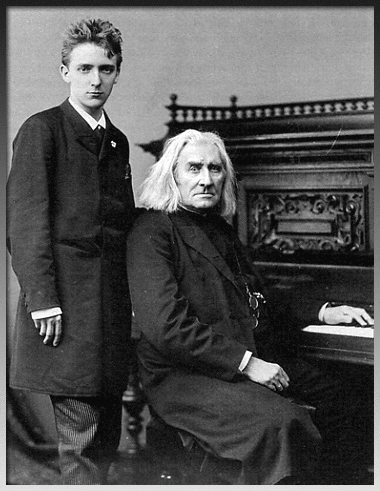
Of the 460 postings on this blog, the most popular ones have been our lists. Many have "gone viral" (which, I guess, is better than "going postal.")
Anyway, just in case you want to see what all the fuss is about, here is a list of our lists -- something for everybody -- even a list about WHY lists are so compelling.
1. 26 Reasons Why Most Brainstorming Sessions Suck
2. 50 Ways to Foster a Culture of Innovation
3. 20 Reasons Why Many People Get Their Best Ideas in the Shower
4. 56 Reasons Why Most Innovation Initiatives Fail
5. 100 Ways to Be More Creative on the Job
6. The 10 Top Reasons Why the 10 Top Reasons Don't Matter
7. 100 Reasons Why You Won't Read This Blog Posting
8. 41 Ways Business Leaders Can Foster a Culture of Innovation
9. 100 Awesome Quotes on What It Really Takes to Innovate
10. 50 Awesome Quotes on Risk Taking
11. The Top 100 Lamest Excuses for Not Innovating
12. 23 Reasons Why Nothing Happens After a Brainstorming Session
13. 14 Ways to Get Breakthrough Ideas
14. The Top 18 High Tech Excuses
15. 20 Qualities of an Innovator
16. The 10 Personas of a Good Brainstorm Facilitator
17. 20 Quotes on the Relationship Between Humor, Play, and Creativity

18. 20 Ways to See the Invisible
19. 101 Creativiteas for the Knew Age
20. 10 Ways to Help Left Brainers Tap Into the Best of their Creativity
21. The Top 100 Learning Tools of 2009
22. The Top 10 Reasons Your CEO Sabotages Innovation
23. 15 Awesome Quotes on Creative Collaboration
24. 6 Ways to Go Beyond Your Assumptions
25. 17 Reasons Why We Love Lists
26. The 4 Currents of a Culture of Innovation
27. The 8 Irresistible Principles of Fun
Who We Are
Our FAQ list
Franz Liszt
Listverse
Wikipedia's rap on lists
History of David Letterman's Top Ten List
Photo Of Franz Liszt
Photo
Photo
Photo
Posted by Mitch Ditkoff at 01:41 PM | Comments (2)
April 13, 2012Ask the Right Questions!
This is the first of several Heart of Innovation postings from the World Business Forum, which we recently attended in NYC. The conference was very inspiring. Great speakers. Timely content. And lots of food for thought (and feeling).
One theme that several presenters noted was the importance of asking the right question.

Tal Ben Shahar: "How do you get others to focus on what works? By asking the right questions."
Tal implored the audience to change the questions they are asking, noting that if we only ask "What's wrong?" (as many business leaders are wont to do), the answers will be unnecessarily skewed in response to that particular filter.
The most serious mistakes being made in business these days, according to Ben Shahar?
Asking the wrong question.
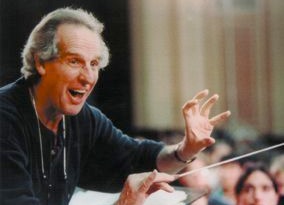 Ben Zander spoke passionately about this theme, as well.
Ben Zander spoke passionately about this theme, as well.
The "rhythm of transformation", he explained, is totally dependent on creating new frameworks -- and creating new frameworks is often a function of being willing to ask powerful, new questions. (Ben, by the way, is the answer to the question: "How do you deliver the most powerfully compelling presentation to 4,000 people sitting on plastic seats at the Jacob Javits Convention Center?"
 Bill Clinton was all over this "question asking' theme, as well.
Bill Clinton was all over this "question asking' theme, as well.
"If we spend all our time asking the wrong questions, we're going to get the wrong answers. If we ask the right question, we still may get the wrong answer, but at least we'll have a chance."
"We're all in the future business", Clinton declared.
Amen. Clearly, if we want to create a future worth living, we will all need to start asking much more powerful questions than ever before -- questions that reflect our growing interdependency and collective need for conscious leadership.
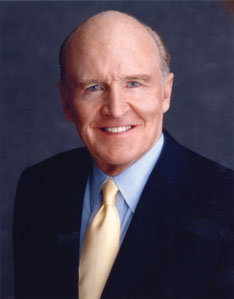 And finally, Jack Welsh weighed in on the topic.
And finally, Jack Welsh weighed in on the topic.
When asked by the interviewer how a business leader can accurately assess an employee's passion, he replied "By the intensity of their questions."
In other words, if you are trying to figure out which person to hire or which employee to assign to a particularly challenging project, make sure you tune into the kinds of questions candidates are asking.
If their questions are flabby or non-existent, it's a dead giveaway that your candidate is ill-equipped to take on the assignment.
If their questions are thoughtful, penetrating, and full of mojo, it's a clue that you are talking to the right person for the job.
SOME QUESTIONS FOR YOUR CONSIDERATION
1. What are you passionate about?
2. How can you make a profound difference on the planet?
3. What do you need to do differently in order to make this difference?
4. Who is your tribe?
5. How can you stay inspired?
6. How can you foster a culture of innovation?
7. What legacy do you want to leave behind?
8. What risk are you willing to take this week?
9. What is your vision?
10. What are your instincts telling you about your hottest, new idea?
Get the right question to brainstorm
Idea Champions
Posted by Mitch Ditkoff at 01:40 PM | Comments (0)
April 10, 2012The Human Side of Innovation

During this morning's Idea Champions team meeting, I had a Homer Simpson moment. You know, one of those classic head slapping, no brainer, high-five, DOH! moments.
And because the aforementioned moment may very well impact YOU, oh savvy reader of this blog, I am going to share it with you now.
Ready? Here it is:
The book on innovation I starting writing last year is already written. Well, at least 50% of it is -- not by some slick consultant who got the jump on me, but by me.
The book, like some kind of buried treasure in my own back yard, is hidden in the more than 450 postings on this blog -- impassioned rants, essays, and wake up calls that address the human side of the innovation equation.
As I've said a thousand time before, organizations don't innovate -- people innovate. Inspired people. Fascinated people. Committed people. People on fire with possibility, mojo, and an almost cellular need to make a difference.
That's what this blog is about. That's what my life is about. That's what your life is about. And that's what my next book is about.
So, I'm rearranging my schedule, redistributing my workload, giving up ESPN highlights, and asking readers of this blog to tell me WHAT they want to see in the book.
What would make it compelling? What would differentiate it from the competition? What would move you to buy it for a friend, your boss, or a client?
HINT: A big chunk of my message is going to be delivered as story -- real-world moments of truth I've encountered "out there" in the corporate workplace. Moments when the veil lifted... a Red Sea parted... and I saw deeply into the heart of innovation.
Like how my company got a huge contract from AT&T by teaching the Director of Training at AT&T how to juggle in 5 minutes.
Like using the martial arts to create a breakthrough at GE.
Like guerilla marketing at Pricewaterhouse, dressed like Santa Claus
If you are a fan of this blog and want to throw your hat or your head in the ring to spread the word, shoot me an email (mitch@ideachampions.com). I'm going create a "MasterMind" group ("MasterHeart"?) to explore cool ways of getting the word out to the rest of the known universe.
If you are an agent or publisher who resonates with all of this, let me hear from you. The door is open.
Posted by Mitch Ditkoff at 11:07 AM | Comments (0)
April 01, 2012Our World Wide Webinatrix Speaks!

The writers of this blog are excited, thrilled, and tickled to announce the launching of a entirely new service to the known universe: Webinars powered by Idea Champions University.
Having spent the past 25 years delivering a wide variety of innovation-sparking workshops, trainings, meetings, conferences, and consulting interventions to forward thinking organizations everywhere, we've decided to let go of our addiction to Frequent Flyer miles and go virtual.
Our new venture began with a simple question: "How can we have the biggest impact on the most amount of people in a cost-effective, highly engaging, low carbon footprint way?"
The answer? Build a webinar curriculum and deliver our services online.
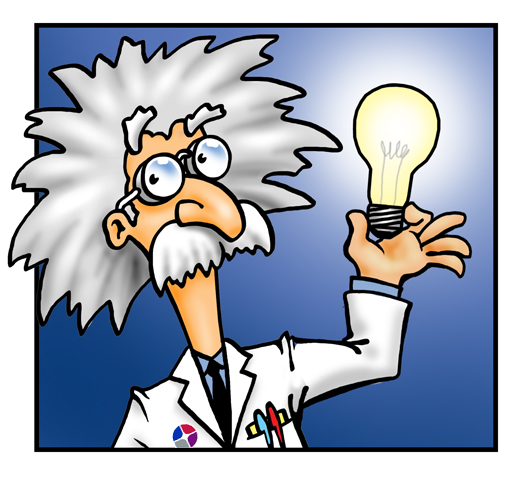
Which is exactly what we've done and will continue to do as long as the need in the marketplace exists.
Bottom line, if you're looking for a better way to build the core competency of innovation, you've come to the right place.
No airfare required. No cabs. No sending your people to overpriced hotels and wondering whose gonna cover for them while they're eating muffins and collecting one more three-ring binder they will never read.
Operators are not standing by. But our website is. And so is our integrity -- the collective mojo we've built for the past 25 years with some of the finest organizations in the world.
So visit us online to learn more about what we're offering. And while you're at it, feel free to register for one of our upcoming open-enrollment webinars -- a great way to kick our virtual tires.

If you are one of the first 50 people to register, you'll receive a 50% discount and a free annual subscription to our highly regarded online Free the Genie app.
If you'd rather schedule a group webinar (for up to 100 people), contact Sarah Jacob, our World Wide Webinatrix.
She means business.
Posted by Mitch Ditkoff at 01:48 AM | Comments (0)
February 08, 2012Consultant Outsources Sleep!

In an extraordinary move, destined to be emulated by forward thinking business leaders everywhere, I've just outsourced all my sleep to a guy named Namdev in New Delhi.
Yes, it's true. I no longer need to sleep. Namdev does it for me. It's astounding how much more productive I've been this week.
And, as if my sleep breakthrough wasn't enough, I've also outsourced all my exercise to a guy named Sung Lee in Malaysia. God bless Sung Lee! He's been on the Stairmaster three hours today and will be working on our delts and pecs tomorrow. Needless to say, I'm feeling totally buff at the moment.
I was just about to have a big piece of cherry cheesecake to celebrate my innovative, time-saving enhancements, but I've outsourced all my eating to a woman named Min Yung in Taiwan. I'm down to 145. Hallelujah! All my pants fit!
The only thing I didn't outsource this week was this blog posting and a visit to my dentist. (Do any of you know someone willing to get a root canal on my behalf?)
I speak!
Idea Champions
Innovation Kits
Free the Genie!
Posted by Mitch Ditkoff at 12:30 AM | Comments (4)
January 14, 2012Want to Innovate? Start Here!
Failure is not what you think it is
Idea Champions
Thanks to Sarah Jacob for the heads up!
Posted by Mitch Ditkoff at 10:52 PM | Comments (0)
January 02, 2012Top Innovation Bloggers of 2011

Well, I've got good news and great news to share with you.
First the good news: I was just voted the #1 innovation blogger in the world in a contest sponsored by Innovation Excellence, the #1 innovation blog in the world.
Now the great news: 2012 is going to be an awesome year for you -- full of happiness, abundance, creativity, collaboration, community, fun, gratitude and, yes, innovation. That is, if you want it to be.
I'd like to take this moment to thank all of you who voted for me. (And by the way, for those of you who think that all I do is write about innovation, please know that this is just a sideline).
My real work is in the trenches...
I'd also like to acknowledge some amazing people who have inspired and encouraged me throughout the years.
These include Evelyne Pouget, Tim Gallwey, Prentiss Uchida, Seth Godin, Gary Hamel, Ben Zander, Roger van Oech, Guy Kawasaki, Erika Andersen, Rumi, Hafiz, Kabir, Morihei Ueshiba, the entire Idea Champions team, Joe and Eddie, Ron Brent, Phyllis Rosen, Joan Apter and, most of all, Prem Rawat (aka Maharaji).

I first heard about Prem Rawat when he was 13 (and I was 24). At that very young age, he came to America (from India) to bring a very powerful message of peace -- a message he doesn't just talk about, but helps people experience for themselves.
He is not the first to talk about this message. Nor will he be the last. But he is here and now -- helping thousands of people, from all walks of life, go beyond ideas to find their way to the source of peace within themselves.
His dedication, brilliance, love, and endless commitment to innovating is a great source of inspiration to me.
Posted by Mitch Ditkoff at 02:11 PM | Comments (2)
December 16, 2011The Atlassian FedEx Day Goes Global

Atlassian is a very successful Australia-based software company founded in 2002. It has 400+ employees, with 125 of them in San Francisco.
It also has more than 17,000 satisfied clients including Google, Netflix, Facebook, Twitter, Skype, LinkedIn, Pixar, Adobe, Hulu, Salesforce, UPS, Nike, and Coca-Cola.
Atlassian's software helps companies organize their data, track it, collaborate about it, and detect/fix bugs in their software.
Yeah, I know... I had never heard of them before either.
But those days may soon be over. Atlassian is fast becoming famous not only for their popular software development tools, but also for their rapidly-spreading innovation creation playfully named "FedEx Day".
Very simply, FedEx Day is a 24-hour innovation immersion event that enables employees to brainstorm, prototype, and pitch their emerging innovations.
Why is it called "FedEx Day"? Because the goal of the 24-hour blitz is for participants to originate, develop, and deliver new products, new services, or business process improvements overnight.
FedEx Days typically begin on a Thursday afternoon at 2:00 pm and end with a spirited round of presentations delivered exactly 24 hours later.
The experience is energizing, empowering, and exciting -- with the company supplying pizza and beer (this DID originate in Australia, after all) for everyone on Thursday night.
The end result? Lots of useful and successful innovations that would not have materialized had employees been required to stick with their "day jobs."
Atlassian has been, internally, conducting FedEx Days (now done quarterly) since 2005. But this program is now spreading like a Charlie Sheen Twitter meme. Many other organizations, like Yahoo, Symantec, Flickr, Hasbro Toy, and the Mayo Clinic have all begun conducting their own versions of FedEx Day.
And, NOW, for the first time ever, Atlassian is offering to send their own FedExperts to one deserving company in order to help them conduct their own FedEx Day.
Explains Jonathan Nolen, one of Atlassian's FedExperts, "It's so exciting. The possibilities are endless. Everyone has great ideas and this gives them a way to unleash the power of those ideas. And it happens all over the organization. It's incredibly inspiring to see this happen in real time."
Atlassian's Annelise Reynolds agrees. "This is part of a new trend in business where companies are understanding the importance of engaging and energizing their employees. It works wonders for both the companies and their employees. The employees have fun and the companies get some great innovations."
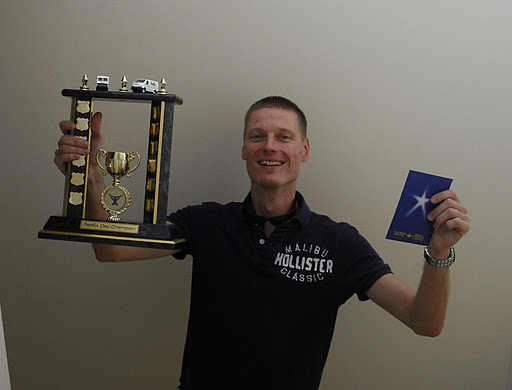
Interested? Want to enter the contest? Click here. Or here to find out what Dan Pink, author of Drive and A Whole New Mind has to say about it.
Entering is simple. All you need to do is fill out this entry form and make a convincing case for why YOUR company or department could use a 24-hour innovation blitz.
Deadline is December 21st, 10:00 PM Pacific Time! Good luck! And good on ya, mate!
- Val Vadeboncoeur
Idea Champions
Posted by Mitch Ditkoff at 07:21 PM | Comments (0)
December 15, 2011The Ten Most Popular Postings on This Blog in 2011
Here's a fascinating factoid:
The 10 most popular postings on this blog in 2011 all had numbers in their headline. Hmmm...
Seems like people are looking for lists and distilled down wisdom -- portals to understanding that somehow quantify the human need to know. Oh, and compilations of quotes.
So here you go, Heart of Innovation's TOP TEN postings as quantified on an scale of 1-10 by our favorite blog analytics service Postrank.
OUR TEN MOST POPULAR POSTINGS FROM 2011
10.0 The 100 Lamest Excuses for Not Innovating on the Job
10.0 20 Reasons Why Creative People Like to Work in Cafes
10.0 41 Ways Business Leaders Can Foster a Culture of Innovation
10.0 35 Awesome Quotes from Einstein
9.9 14 Ways to Get Breakthrough Ideas
9.4 The 8 Dimensions of a Brainstorm Session
8.7 5 Ways to Jump Start a Culture of Innovation
8.6 50 Awesome Quotes on Vision
8.5 100 Awesome Quotes on What It Really Takes to Innovate
8.5 100 Simple Ways to Be More Creative on the Job
Posted by Mitch Ditkoff at 01:00 AM | Comments (0)
November 22, 2011I Am Asking for Your Vote

Dear Heart of Innovation Readers:
If you believe I have added any value to the field of innovation/creativity this year, I humbly ask for your support. I have just been nominated by a leading speakers bureau as a "Top Speaker" in the field of innovation/creativity -- and am asking for your vote.
Simply click here, and click the box next to my name (Mitchell Ditkoff) in the Innovation/Creativity category.
The whole thing should take you less than a minute. Maybe 30 seconds if you've just had your morning coffee.
Thanks for your support!
Posted by Mitch Ditkoff at 09:13 AM | Comments (0)
November 19, 2011Your Message For the Day

Free the Genie
Idea Champions
Ingenious Leadership
Posted by Mitch Ditkoff at 11:43 PM | Comments (0)
November 13, 2011Obvious to You, Amazing to Others
Derek Sivers, Founder of CD Baby, used to live one street away from me in Woodstock, NY. I saw him only once, walking on the road. Now here he is on YouTube. Yo, Derek! Thanks for this! So true...
Posted by Mitch Ditkoff at 12:01 AM | Comments (0)
September 26, 2011The Six Sigma Blues

One of my favorite clients of all time was a key manager in a prominent Fortune 500 company.
She was smart. She was funny. She was creative. And she was kind.
Then her company adopted Six Sigma.
I couldn't help but notice that soon after this she started becoming very cranky, not unlike the way an artist gets upon filling out a tax form.
When I asked her how the Six Sigma initiative was going, she rolled her eyes and mumbled something about "going through the motions."
In a lucid online Business Week posting, Brian Hindo deconstructs some of the flawed assumptions of the Six Sigma approach.
"The very factors that make Six Sigma effective in one context," explains Hindo, "can make it ineffective in another. Traditionally, it uses rigorous statistical analysis to produce unambiguous data that help produce better quality, lower costs, and more efficiency. That all sounds great when you know what outcomes you'd like to control. But what about when there are few facts to go on -- or you don't even know the nature of the problem you're trying to define?
"New things look very bad on this scale," says MIT Sloan School of Management professor Eric von Hippel, who has worked with 3M on innovation projects that he says 'took a backseat' once Six Sigma settled in.
"The more you hardwire a company on total quality management, the more it is going to hurt breakthrough innovation," adds Vijay Govindarajan, a management professor at Dartmouth's Tuck School of Business. "The mindset that is needed, the capabilities that are needed, the metrics that are needed, the whole culture that is needed for discontinuous innovation, are fundamentally different."
And so, dear Heart of Innovation readers, in honor of all people who have ever questioned the long-term value of Six Sigma... in honor of all the people who have understood that increasing -- not decreasing -- variability is often the key to success, it is my utmost pleasure to make my graceful exit from this latest blog posting with the immortal, finger-snapping, toe-tapping, knee-slapping, put-on-your-blues-hat-and-sunglasses lyrics to....
THE GOTTA HAVE A PROCESS BLUES
I woke up this morning,
put both feet on the floor,
but I didn't have a process
to find the bathroom door,
so all I did was shuffle,
first the left foot, then the right,
forgot to count the tiles,
(hey boss, I ain't too bright.)
We got green belts, black belts,
corporate karate,
and soon we'll need a process
for going to the potty.
Lord, I need a chart and graph to help me choose
just what to name this song about the Six Sigma blues.
Back when we were kids
the only processed thing was cheese,
now we need a process
every single time we sneeze,
I say "achoo," I blow my nose,
I try to get it right,
my Black Belt says my charts don't flow,
not once a gesundheit.
I make no mistakes,
I do everything right --
to make sure nothing breaks,
I stay up all night,
I'm a Six Sigma cowboy
cutting cycle time in half,
I measure every joke
and the way it makes me laugh.
We got green belts, black belts,
corporate karate,
and soon we'll need a process
for going to the potty,
a fishbone diagram would be so cool to help me choose
just what to name this song about the Six Sigma blues.
I barely make a boo boo, I rarely blow a deal,
you might call it voo doo, but that's just how I feel,
I'm one in a million
though my defects number three,
I log on while I'm sleeping
and I've changed my name to "E."
We got green belts, black belts,
corporate karate,
and soon we'll need a process
for going to the potty.
-- Blind Willy Nilly (aka "Mitch Ditkoff")
Photo
Face the Music
Idea Champions
Posted by Mitch Ditkoff at 10:10 PM | Comments (2)
September 23, 2011Catalyze This!
Every once in a while one of our clients really gets it. And when I say "it", I am not referring to stock options, narcolepsy, or the Nobel Prize.
The "it" I am referring to is the meme, the mojo -- the main meaning of our message -- a message, I am happy to say, that is not really OUR message, but the message of a billion aspiring innovators since the beginning of time.
Lo, I say unto you, the extraordinarily perspicacious Ken Mendelkern, Senior Account Supervisor of Catalyst Public Relations, in New Yawk City -- has just published this fine looking blog specimen on the Catalyst blog -- giving heartfelt props to Idea Champions (that's us, folks) in response to a four-hour ideation session we facilitated, last Friday, in Catalyst's finely appointed Empire State Building offices.
Read it and leap!
We like Catalyst. We think they're smart, funny, focused, and have exceedingly good taste.
Posted by Mitch Ditkoff at 11:16 PM | Comments (0)
September 11, 2011Out of the Ashes, Breakthrough!
I am thrilled to publish the following article by Steve Cronin, a brilliant inventor who attended one of my innovation trainings ten years ago to the day. Thanks, Steve, for stepping up and speaking your truth. Keep on innovating!
"Almost everyone knows what 911 represents. Emergency! Help! Chaos! After September 11th, 2001, nine-one-one became nine-eleven and those numbers took on a whole new meaning.
Without a doubt, it was a day that changed the course of history -- a day that woke up an entire generation of Americans to a very real threat of terror at any time, any place.
I certainly remember where I was ten years ago on September 11th, 2001. The day was so vivid for me, in such a unique way, though I was nowhere near New York City or Washington.
I was in Akron, Ohio, at a Hilton Hotel, attending a one-day innovation training being facilitated by Idea Champions.
A couple of hours into the course we were on a break, at the hotel lounge, when the news flashed on a huge TV screen -- news of a plane hitting the World Trade Center, and then, a few minutes later, news of a second. All of us stood there in disbelief, shocked and confused.
What had just happened?
Our instructor, Mitch, was calm, but like most of us, in a bit in shock himself. It was much more personal for him, as he lived near New York City and had to make a couple of calls to make sure everything was OK.
The more I thought about what I had just seen; an unexpected determination began to grow inside of me. As the training progressed, those images stayed in my mind. I was determined to do... something. But what? What could I do?
At that time in my career, I was working in product development at Goodyear Tire and Rubber, with a focus on aircraft tires. I was what they call a "compounder", a person who created compounds to make aircraft tires better.
So there I was, watching planes crash into skyscrapers, destruction everywhere, while I was in a class devoted to creation, innovating something new, making things better, not worse.
That day changed me forever.

It was the day I knew I was meant to innovate something extraordinary. I knew that if I focused, something good would come out of something so evil.
So began my journey to develop a completely new aircraft tire tread compound.
It was not easy, and I surely didn't do it alone, but with time, hard work, and persistence, it happened.
When all was said and done, I had created a new tread compound, one of the best in the world for landing performance -- a product composed of materials that many people, including a high ranking official at NASA, said could not possibly work.
But I persisted. I knew, in my gut, that with a creative approach, it had to be possible. The feelings of that day, 9/11/01 stayed with me. I remained focused on the core principles of innovation, and I let the inspiration flow from the spirit within me.
In recognition of my efforts, I was named -- along with a few other collaborators -- Corporate Inventor of the Year in 2008. Yes, a little bit of good did come out of that day known as 9-11.
As Einstein so rightly stated: "In the middle of difficulty lies opportunity".
It's up to each of us to find that hidden opportunity and make it real!
It's difficult to say why we become who we become. Is it our genetics? Is it our life experience? Is it all predetermined?
I often ask myself why I was at Mitch's innovation class on 9-11, but looking back it's pretty obvious why. But regardless of the why, I can say without a doubt that I am hopelessly and passionately in love with innovation -- maybe even addicted to it. I can't think of anything nobler than to simply create, to innovate.
It's what I chose to do for the rest of my life.
Posted by Mitch Ditkoff at 01:10 AM | Comments (0)
September 06, 2011I Don't Just Write This Blog, I Talk, Too -- As in Keynote Presentations

I am happy to announce that Core Speaker's Agency has stepped up to the plate and taken me on as one of their featured keynote speakers in the field of innovation.
I am also very ably represented by Speaker's Platform.
This is good news because both of these savvy bureaus are way better at representing me than I am at representing myself.
In the past 9 months, I've delivered keynotes for National Institutes of Health (twice), EXL, National Multiple Sclerosis Society, Inpex, Intertek and, in October, BASF.
Here is a link to the topics I am currently offering.
Here's my approach to keynote speaking.
Posted by Mitch Ditkoff at 04:23 PM | Comments (0)
May 23, 2011Reinventing the Technology of Human Accomplishment
Here is an impassioned, inspired, lucid, refreshing 15-minute presentation by Gary Hamel on the need for organizations to radically reinvent the way they manage their people. Hamel not only builds a compelling case for something you've always felt (but never quite had the words to express), he uses motion graphics in a way that adds major mojo to his presentation.
Posted by Mitch Ditkoff at 11:56 PM | Comments (1)
May 18, 2011I Breathe, I Blog, I Speak

Guess what? I don't just write this blog. I speak!
Yes, I speak. I really do.
As in give keynotes to large audiences who want to get out of the box and raise the bar for innovation. People who want to tap into their brilliance, brainpower, and buoyancy -- aspiring innovators, creative thinkers, difference makers, movers, shakers, and anyone else who wants to find a better way of getting the job done.
I am pleased to announce that I am now being represented by the extraordinary Mike Frick, Founder of Speakers' Platform and Core Speakers Agency.
Give Mike a call today -- 760.673.7700. He speaks, too.
Ten Tips for Giving a Great Keynote
Idea Champions
My blog
My clients
Posted by Mitch Ditkoff at 11:59 PM | Comments (0)
April 16, 2011How the Ivy League is Killing Innovation
Here's a wonderful article, just published in Bloomberg Business Week that raises a very curious paradox -- why academics are teaching innovation.
Authors G. Michael Maddock and Raphael Louis Viton state their case clearly, cleanly, and with just enough of an edge to draw blood.
"Process-driven cultures love process-driven experts. Organizations, just like people, do what makes them feel strong, and nothing makes mature, process-driven companies feel stronger than having a template for doing anything (even if having a completely buttoned-down-ain't-no-exceptions-allowed template for innovation seems oxymoronic on its face).
Need innovation? Simply call in a PhD with a bow tie and trademarked process and watch your innovation portfolio grow. Right? Nope."
If you are a professor and find Maddock and Viton's article objectionable, speak up! Let them know what you think -- and why. Maybe you're the one who's found a way to teach innovation in a novel, cut-to-the-chase, non-academic way. I know there are some of you out there. Yes?
If you are a high roller in a corporation looking for the "secret innovation sauce," I invite you to read their article before reaching out to academia for your next keynote speaker.
Posted by Mitch Ditkoff at 07:11 PM | Comments (0)
April 14, 2011Beer and the Invention of the Wheel
You may not know it, but I wrote an award-winning book in 2008, Awake at the Wheel. It's a business fable about the creative process. Easy to read. Fun. A real support for aspiring innovators.
I'm guessing the caveman in the Bud Lite ad below would have found a better way of getting their beer to the party if they had read it.
But enough about me. Let's talk about YOU.
Do you have a creative venture that needs an infusion of mojo, inspiration, and clarity?
Yes? Good. Click. Buy.
Posted by Mitch Ditkoff at 02:22 PM | Comments (0)
April 04, 2011Getting Out of the Organizational Box
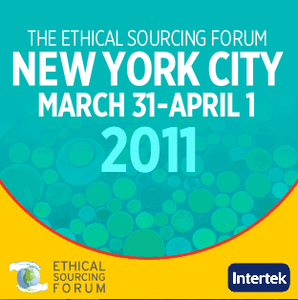
Last Thursday, I had an opportunity to be the keynote speaker at the Ethical Sourcing Forum, in NYC, a conference sponsored by Intertek, a world class organization dedicated to "helping customers improve performance, gain efficiencies in manufacturing and logistics, overcome market constraints, and reduce risk."
The topic? Sustainable Innovation. Or, more specifically, how people who work in large organizations can get out of the so-called "box".
After the keynote, I was approached by two very animated people from 3BL, a savvy media company specializing in corporate social responsibility, sustainability and cause marketing communications. Apparently, they liked what they heard and wanted to dig deeper -- on camera.
So, it was off to their make shift media center down the hall for an impromptu interview. Click here to watch the 7-minute video.
My innovation keynotes
My speaker's bureau
Posted by Mitch Ditkoff at 03:40 PM | Comments (1)
March 19, 2011Products of Our Imagination
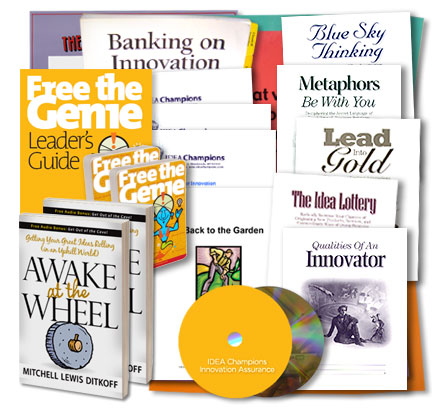
We now interrupt this highly inspiring, thought provoking, mostly unmonetized innovation blog to pay the bills.
If you are looking for a simple way to think outside the box and spark some real innovation in your company, take a look at two cool products from the people who bring you this blog -- our Silver Innovation Kit and our Platinum Innovation Kit.
And, because we're in a really good mood today and our CFO is on vacation, we'll kick in an annual subscription to our highly regarded Free the Genie if you place your order before April 15th.
Posted by Mitch Ditkoff at 02:27 PM | Comments (0)
March 03, 2011What, Exactly, IS the Box?
"Innovation" is the holy grail for most organizations. Everyone wants it. Everyone talks about the need to "get out of the box" and do something different. But there's a huge gap between the rhetoric and the reality.
The reasons are many -- but the biggest reason is this: No one really knows what the so-called box really is.
And because we don't, we end up shadow boxing imaginary monsters -- coming up with untold processes, protocols, and pep talks that don't really get to the heart of the matter. Not a good idea.
So, dear aspiring innovator -- what do YOU think the box is?
Next week, in this space I will share my current understanding of the box, name all six sides -- and kick start the conversation of how you, your organization, and the rest of world can get out of it.
Posted by Mitch Ditkoff at 10:40 AM | Comments (0)
December 03, 2010What You Can Learn from the Bloody Mary
In 1939, a Russian immigrant owned the rights to distribute vodka in the U.S. His efforts bombed, big time. Americans weren't interested in a colorless, odorless alcohol.
Depressed, he sold the rights to Heublein, who asked themselves: "What can we combine with Vodka to give it a distinctive taste and color?"
They came up with tomato juice and, voila, the Bloody Mary was born. Sales? Through the roof.
What most of us think of as an "innovation" is really just the elegant combination of two (or more) pre-existing elements resulting in the creation of a new, value-added product or service.
Want to try it for yourself? Click here for a cool, interactive technique.
Posted by Mitch Ditkoff at 01:39 PM | Comments (0)
August 10, 2010Getting Down to the Business of Creativity
Here's a terrific article on creativity, based on the work of three Harvard researchers/professors.
According to Teresa Amabile's research, "inner work life" is one of the biggest determinants of creative output. In other words, a positive mood is a pre-condition for creativity in the workplace.
If you are attempting to establish a sustainable culture of innovation in your organization, you (and everyone else) would be well-served to do everything humanly possible to positively impact the mood (i.e. tone, feeling, atmosphere, vibe, spirit) of the environment in which you work.
And that begins, of course, with the individual.
When you treat people with respect, acknowledgment, and genuine positive reinforcement, you significantly increase the odds of creativity -- and by extension, innovation -- flourishing in your organization.
Common sense? For sure. But common sense is all too uncommon in most organizations these days. In our rush to produce, get an edge, and accomplish, we forget the most important thing -- and that is the quality of our interactions with others.
Posted by Mitch Ditkoff at 05:35 AM | Comments (0)
May 04, 2010Definitions of Innovation
I just googled "definitions of innovation" and came up with 5,240,000 choices. Good luck reading them. For now, here are 10 I've gathered over the years that I like. How about you? And if you have a better one, let me know.
"Change that creates a new dimension of performance." - Peter Drucker
"The ability to deliver new value to a customer." - Jose Campos
"Adapting, altering, or adjusting that which already exists for the sake of adding value." - Anon
"The managed effort of an organization to develop new products, new services, or new uses for existing products or services." - Ricky W. Griffin
"The commercialization of creativity." - Anonymous
"The creation, development and implementation of a new product, process or service, with the aim of improving efficiency, effectiveness or competitive advantage." - Government of New Zealand
"Creating something before people know they need it. - Guy Kawaski
"The successful exploitation of new ideas." - UK Department of Innovation and Skills
"The successful implementation of creative ideas within an organization." - Teresa Amabile
"The act of introducing something new." - The American Heritage Dictionary
Illustration from the back cover of my book
Posted by Mitch Ditkoff at 01:05 PM | Comments (2)
April 14, 2010Shameless Self-Promotion #23
It's recently dawned on me that a lot of the readers of this blog have no clue what the authors of this blog actually do -- or what companies we (Idea Champions) have helped along the way.
So... in case you are wondering... take a look.
We've worked with just about every industry on planet Earth. Our clients have included: GE, AT&T, Lucent, General Mills, Chubb Insurance, Coca Cola, Allianz, Met Life, Con Edison, Goodyear, Michelin, MTV Networks, A&E Television, Merck, Pfizer, NBC Universal, Atlanticare, Mitre, Pricewaterhouse, Towers Perrin, Gap, Rio Tinto, Duke Corporate Ed, Dover Corp, Fuqua School of Business, Citibank, Scotia Bank, Babson College, MBooth & Associates, and a host of other forward thinking organizations.
Oh, I almost forgot, our Free the Genie tool is going virtual in about a month or so. Want a preview? Let us know.
Posted by Mitch Ditkoff at 01:31 PM | Comments (0)
November 29, 2009Vote for Me Today!

GOOD NEWS! I've just been nominated as a "Top 5 Speaker" in the field of innovation & creativity by a prestigious speaker's bureau. Now the fun begins... and the voting.
If you have 30 seconds and feel that I have made a meaningful contribution to this field, click the link below, scroll down to #7, and check the box next to "Mitchell Ditkoff." Thanks!
Posted by Mitch Ditkoff at 08:39 AM | Comments (0)
December 22, 2008The Power of a Single Idea
Take a look at what one person, with a good idea and a lot of chutzpah, can do. It's MATT, a self-described "32 year old deadbeat from Connecticut" who travelled to 42 countries on 7 continents in 6 months and got thousands of people dancing and laughing with him. What seemingly outlandish idea of YOURS is it time to unleash?
Posted by Mitch Ditkoff at 02:06 PM | Comments (0)
December 15, 2008Hard Times Can Drive Innovation
Great interview in the Wall Street Journal with Clayton Christensen (author The Innovator's Dilemma and Seeing What's Next etc.)
Here is Clayton's response to being asked what impact the economic downturn will have on innovation:
"One of the banes of successful innovation is that companies may be so committed to innovation that they will give the innovators a lot of money to spend. And, statistically, 93% of all innovations that ultimately become successful started off in the wrong direction; the probability that you'll get it right the first time out of the gate is very low.
So, if you give people a lot of money, it gives them the privilege of pursuing the wrong strategy for a very long time. In an environment where you've got to push innovations out the door fast and keep the cost of innovation low, the probability that you'll be successful is actually much higher."
Posted by Mitch Ditkoff at 12:42 PM | Comments (0)
December 14, 2008Juggling, Creativity, and the Beatles
Twenty years ago, we got our first big contract by teaching AT&T's Director of Training and Development how to juggle in five minutes. (The man had been trying for 25 years). After we taught him, he looked at us and said, "I have no clue what you guys do, but I know you're not a juggling company. Call me on Monday." We did. Three months later, AT&T licensed our creative thinking training. It all began with a juggling lesson. Speaking of which, click below to watch the amazing Chris Bliss take juggling to an entirely new level...
Posted by Mitch Ditkoff at 02:37 PM | Comments (0)
December 08, 2008How do you get to Carnegie Hall?
We are what we repeatedly do. Excellence then is not an act, but a habit. - Aristotle
When I was in high school, I entertained the possibility of a career in music. I practiced the trumpet every single day for four years, even when I was ill. Ultimately, a musical career was not to be for me but I regret not a moment of practice. I learned a lot about myself and my capacity for discipline besides deepening my appreciation for music which has been a lifelong pleasure.
I also remember to this day the words of my first trumpet teacher, Irving Renquist, who once said when I first began studying with him that "If you skip practice for one day, you will notice it. If you skip practice for two days in a row, the people you live with will notice it. And if you skip practice for three days in a row, EVERYONE will notice it!"
Musician and neuroscientist, Daniel J. Levitin, in his thought-provoking This is Your Brain on Music, points out that scientific studies indicate that "ten thousand hours of practice is required to achieve the level of mastery associated with being a world-class expert - in ANYTHING!" Then, to be helpful, he reminds us that ten thousand hours is equivalent to "roughly three hours a day, or twenty hours a week, of practice over ten years." Well, we knew that it was a lot.
For me, this research indicates that what we often call "talent" is often a "capacity for practice" which recalls to mind, in turn, Eric Hoffer's contention that "success is a species of vigor." Of course, this may well be a chicken or egg debate because why would you want to practice for ten thousand hours at something you weren't predisposed to be good at or had at least some kind of talent which could be further developed?
Chicken or egg, whenever we are in awe observing someone's excellence in anything, we are most usually watching the end result of thousands of hours of diligent practice and thousands upon thousands of "mistakes" made and corrected.
I'm always reminded of this when I come to the end of one of our Conducting Genius sessions (as I did recently at AtlantiCare, a very successful New Jersey healthcare organization), where we train a small cadre of participants to become effective brainstorm facilitators/innovation change agents.
No matter how well I've managed to transmit the inner and outer game of eliciting ideas from others, and no matter how intelligent and dedicated the participants are, I know that their future success as innovation change agents depends on how much they will practice using the techniques and insights of the training.
And how much they practice depends on how many opportunities they can find for themselves and THAT depends, in turn, on how supportive their organization is to innovation, in general, AND in exploiting innovation opportunities as they arise, in particular.
This is why I try to drive this point home during Conducting Genius sessions by teaching our budding "innovation ninjas" how to juggle. In one lesson, most of them can't become proficient jugglers, of course, but they DO learn the step by step process of learning HOW to juggle. The missing ingredient? Practice!
The same is true with learning how to innovate on the job, how to run effective brainstorm sessions, or how to do anything, as Levitin reminds us. If we want to master anything in this world, we have to consistently practice that skill, art, craft, science, behavior, thought process, what have you...AND make lots and lots of "mistakes" on our way to mastery. There is no getting around this truth.
So, the next time you see someone exhibiting mastery in juggling, music, sport, cooking...or innovation...remember that you are witnessing a perfection that is the end result of at least ten thousand hours of dropped balls, missed notes, or souffles which don't souffle.
And also remember, that when it comes to innovation, you and your company have to diligently practice the skills, processes, and behaviors that support it. If you don't, EVERYONE will notice it.
Posted by Val Vadeboncoeur at 03:19 PM | Comments (0)
November 13, 2008Forget About the Box, Get Out of the Cave!
See the caveman to your left? That's Og. He's the protagonist of my new book, Awake at the Wheel: Getting Your Great Ideas Rolling (in an uphill world). The word "protagonist" is not in Og's vocabulary. Even I don't use the word "protagonist" all that much -- though I have used it three times in this paragraph.
Hmmm... That's pretty odd.
Then again, the experience of inventing the wheel was pretty odd, too. Which is what Og did. 24,000 years ago. Long before Game Boy, i-Pod, or Starbucks. And yes, long before the Mesopotamians -- the people who usually get all the credit for the wheel -- some 20,300 years after my main man, Og.
(Hey, when was the last time you used the word "Mesopotamian?" That's another word not in Og's vocabulary.)
Actually, Og didn't need a big vocabulary. He had something else going for him: Neanderthalic genius. Stone age brilliance. Originality. Og, you see, was the first innovator. Intrinsically motivated, he was. Fascinated. Inspired. Mojo-driven. And while he was not without imperfections, he needed no attaboys, cash awards, or stock options to follow his muse.
Back in Og's time, when men were men, and stones were stones, even the idea of an idea was unthinkable. And yet... somehow, he had one -- an IDEA, that is -- and not just your dime a dozen variety. Nope. A GREAT idea, a BIG idea, or what I like to call an "out of the cave" idea: The wheel.
Ah... but I go on too long. If Og were here, he'd be frowning by now, shrugging his stooped shoulders, wondering in his delightfully pre-verbal way what other new ideas and discoveries awaited his wonderfully hairy touch.
Want to order the book now? (Og gets 10% of every sale). Go ahead. Help him put bear meat on the table.
Posted by Mitch Ditkoff at 11:37 AM | Comments (1)
November 05, 2008Baking the Change and Innovation Cake
Last night, my 11-year old daughter, Mimi, and her good friend, Zoe, stayed up late to watch the election results. After Obama was declared the winner, they baked a cake in his honor and, in the morning, frosted it.
As they left the house this morning, Mimi stopped, cake in hand, and shouted out Obama's name at the top of her lungs. Something deep within her rose to the surface and begged to be expressed. Which, being 11 and free of the politically correct constraints that rule the lives of too many adults, she accomplished with great flair.
That same intrinsic motivation that moved Mimi and Zoe to bake their cake, needs to be alive and well in your company if you are truly serious about raising the bar for innovation and change. Mimi and Zoe didn't need to be TOLD to bake the cake. They wanted to. Even more than that, they HAD to.
FOOD FOR THOUGHT: In what ways can you create the kind of culture in your organization that will encourage everyone to bake their cake for change and innovation?
Posted by Mitch Ditkoff at 10:22 AM | Comments (0)
November 04, 2008"It's No Time to Forget About Innovation"
Writing in the New York Times, Janet Rae-Dupree reminds us that even or especially in times "of corporate belt-tightening," companies reduce their efforts to strengthen innovation at their own risk.
She quotes Jon Fisher, a business professor, serial entrepreneur, and author of "Strategic Entrepreneurism," saying, "'Innovation has to be embedded in the daily operation, in the entire work force.' Addressing companies whose aim is to be bought by a major player in their vertical, he explains, 'A large acquirer's interest in a start-up or smaller company is binary in nature: They either want you or they don't, based on the innovation you have to offer.'
"In fact, hard times can be the source of innovative inspiration, says Chris Shipley, a technology analyst and executive producer of the DEMO conferences, where new ideas make their debuts. 'Some of the best products and services come out of some of the worst times,' she says. In the recession of the early 1990s, 'tiny Palm Computing managed to revitalize the entire industry in a matter of months.'"
Also on the encouraging side: as I write this, Rae-Dupree's article is number six on the most-emailed in the Business section.
"It's No Time to Forget About Innovation" - NYT, 11/1/08.
(Illustration: The White Rabbit, by John Tenniel (1820-1914), from the original "Alice In Wonderland.")
Posted by at 04:17 PM | Comments (0)
October 29, 2008Idea Champions' Economic Bailout Package for U.S. Corporations
It's Fall in America, usually a very beautiful season, with leaves turning color and Thanksgiving just around the corner.
But there's something else in the air these days -- and that is a savage economic downturn. It's not just the leaves that are falling. It's also the stock market, housing prices, consumer confidence, and 401Ks. Ouch!
While Democrats and Republicans are both promising major fixes to the economy, no one knows exactly how long it will take. Some pundits are predicting YEARS. But your business can't afford to wait years. You need a quantum leap -- and you need it NOW -- innovation made real.
That's why IDEA CHAMPIONS has decided to offer one lucky company -- maybe YOURS -- our own economic bailout package...
HERE'S HOW IT WORKS:
1. You email us a description of your company, it's mission, and why we should donate one day of our time to help your company succeed.
2. We'll carefully review all submissions and select one company to offer our services to -- at no charge (other than expenses).
3. Which services? One of the three listed below.
Do More With Less
High Velocity Brainstorming
Team Innovation
THE FINE PRINT
1. Deadline to apply is December 1.
2. Your only cost is our expenses -- no cost for the session.
3. Existing Idea Champions clients (or prospects) are not eligible.
Whether or not you choose to respond to our offer, please remember to keep your perspective and your sense of humor. Life is STILL good, even if your cash flow is out the window. The DOW might be down, but you don't have to be.
Enter today: info@ideachampions.com
Posted by Mitch Ditkoff at 11:25 AM | Comments (0)
August 11, 2008Big Problem or Right Problem? The Egg Freckles Saga.
Have you ever spent hours trying to solve a problem only to find you've been working on the wrong problem? Try doing it for five years. That's what Apple Computer engineers did with the Newton handheld computer over a decade ago.
From 1993-1998, Apple made a valiant effort to break open a market for portable handheld pen computers. Unfortunately, they spent most of that time working on a problem that didn't really exist for consumers. And as they labored at it, their intended market was stolen by Palm Computing's PalmPilot.
What follows is a tale about a fatal assumption -- an obsession with a Big Problem that led to one of Silicon Valley's great product misfires.
Consider the moral first.
Solving a Big problem doesn't mean you're solving the Right problem.
Apple's team chose to tackle the biggest challenge in pen computing: high-level handwriting recognition. Newton would be the first portable computer people could write on directly using their natural hand. From anyone's scrawl, the computer would extract the standard ASCII characters computers need to work with. This posed a massive challenge in pattern recognition. Since every user's handwriting is different, the Newton would need to learn the particular way its user wrote each letter and number. IF it got all the letters in, say, the word "thing" right, Newton would compare that string of letters to words in its 10,000 word native memory. IF the word "thing" was stored there, Newton would find a match and "know" the word.
The Newton team was determined to build the world's most sophisticated pattern learning pen computer. But why were they doing it? And for who? Here they made one fatal assumption about their potential buyer, an assumption that would seal the Newton's fate.
The assumption went something like this:
"Users want to do things the way they've always done them. The user shouldn't have to learn anything new to adapt to a machine. A smart machine can and should adapt to the user (in this case, learn the user's handwriting)."
This assumption became a frame and the frame became a mindset. Without ever turning back to question their customer premise, Newton's team labored to build a noble, mind-blowing machine that could recognize the diverse scrawls of any and every human on Earth. But was this the Right Problem to solve?
When the Newton Message Pad debuted in 1993, its handwriting recognition fell way short of the mark, and a public drubbing ensued. The Doonesbury comic strip showed a character writing a six-word sentence on a Newton-like hand-held. The unit coughed up "Egg freckles?" Then The Simpsons piled on. The world laughed.
All through 1993, the Newton was skewered in the press. In October of that year, Apple CEO John Sculley left with freckled egg on his face. Humiliated, the Newton team redoubled their efforts to solve their core problem: getting Newton to learn better.
At the heart of Newton's learning challenge was the "second-stroke problem." Each time a user's pen lifted off the tablet and set back down, Newton's brain detected a pause and became uncertain. "What did that pause mean? Is this next stroke part of the current letter, or a new letter or word?" As it turns out, many alphabet characters need multiple strokes, leaving plenty of room for uncertainty. Capital "T" and "X" involve two strokes. "H" needs three. Add user hesitancy and writing quirks, and you have a thorny problem. And that's just English. Try Cyrillic or Japanese ideograms.
Because Newton's recognition engine was unsure so often, it routinely threw a list of possible words at the user. This was both inconvenient and embarrasing. Who wants their computer to say, "I'm confused. Take time out, scan these words and select the right one"? Worse, if you wanted Newton to learn a word outside its native 10,000 word database, you had to train it. You first had to write it your way, then type it letter by letter using an on-screen keyboard. All that to tell Newton, "This is what 'Hoboken' looks like when I write it."
The upshot? To "save" users from having to adapt their writing habits to machines, the Newton subjected ordinary people to drawn out and repetitive clarification and training routines; a tacit admission that Newton wasn't doing its core job cleanly.
None of this was lost on Jeff Hawkins, inventor of the Palm Pilot, who was carrying around a wooden block as a pretend pocket PDA and using a whittled down chopstick as a pen to imagine his interface.
Hawkins never lost sight of what consumers would want most in a pen computer: fast writing and true mobility - something they could fit in their shirt-pocket. He cut to the chase and questioned Apple's core assumption:"Why must the computer learn everything? Why can't users adapt? Why build a sophisticated learning machine at all? Let's get the job done. People learn faster than computers, so why can't people help the machine? People could easily get the hang of a new single-stroke alphabet. Hmm. One stroke per character and presto! No more second-stroke problem."
So that's what Jeff Hawkins did. With his Grafitti language, he simply redesigned the alphabet, turning centuries-old letters and numbers into single-stroke symbols that mostly kept the look of the original characters. Suddenly the computer had only one master rule to follow. "When the pen lifts up, the character is done. When the pen comes down again, it's a new character. Want to end a word? One stroke makes a space." Simple. And while we're at it - since each stroke is a new character, lets not even write along a line. Write letters on top of each other, in the same input space, and let them display as type in another. Presto - a smaller screen.
Hawkin's low-tech solution made Palm Pilot's pen input "good enough." (Apple even licensed Grafitti in 1995 as an input option for the Newton. Some say it kept the Newton alive.) But the real power of Grafitti was size. It shrank the screen, which shrank the box, which created a viable pocket-PDA market.
In March, 1996, when Newtons were selling as digital writing tablets for up to $1000, the first pocket-sized PalmPilots debuted for under $300. A million of them sold in the first 18 months. The Newton team countered with a much improved Newton 1000 and 2000, but by then it was too late. Two years after the PalmPilot was released, Apple cancelled the Newton product line on February 27, 1998. The project had cost the company half a billion dollars.
Hawkins "technology" was a low-tech workaround; it wasn't "handwriting recognition" in the high-level MIT sense. But while PhD's may have felt Grafitti was a cheat, ordinary people, not giving a hang about the technology issues, found PalmPilots handy and useful. While engineers rallied around solving the Big Problem, consumers swarmed to buy the solution to the Right Problem, which started with a chopstick and a block of wood.
By year 2000, Palm owned 70 percent of PDA sales and had sold well over five million units. At the peak of PDA use, white boards everywhere were covered with Grafitti symbols, which many considered faster to write for high-velocity brainstorming.
The Newton team spent five years working on the Big Problem, writing and rewriting untold lines of code to create a learning machine for the existing alphabet. Hawkins spent a few days designing a new alphabet any computer could easily understand.
Despite its truly impressive interface, Newton stumbled at the main task it promised to do - turn writing into standard ASCII characters quickly. And why did Apple paint themselves into this corner? Because they assumed consumers would want their handheld to adapt to their personal way of writing. Instead of biting into Apple's Big Problem, Jeff Hawkins assumed people would adapt. As he once put it, "It takes you weeks or months to learn how to type, so why not spend 15 minutes learning [how to talk to a computer] with a pen?"
The Lessons
In hindsight, Apple's underlying user assumptions made little sense. What makes people's standard routine (handwriting) so sacred? Who said people shouldn't adapt to machines? Who said you had to work with the existing English alphabet? Why make a program strain to recognize every possible variant of every letter and number? Who said your program had to recognize scrawled words by finding them in a limited word database? Engineers set up these problems, not users.
Great minds often get hijacked by their own brillliance and vision. They forget that simple is smart, dumb is basic and low-tech often beats high tech. We can get so obsessed with an elusive quarry and so enamored of our intelligence that we never go back up to the 20,000 foot level and see that we're hacking the wrong problem. The famous monkey trap metaphor is worth repeating here.
If a monkey reaches through a hole for a banana, but the hole is too small for her hand to withdraw with the banana, she's presented with a quandry. "Which do I want? - the banana or my freedom?" All she has to do is let go of the banana in order to be free of the trap. But the monkey doesn't let go of the banana. She sits there determined to extract it, even in the face of being captured.
Big Problems are like monkey traps. If your Solution quest starts feeling "heroic," or your Big Problem is "big" mostly because everyone is trying to solve it (big kudos await if YOU solve it), its likely you're trapped by the epic magnitude of your quest. In that mindset, the simplest options are likley to escape your notice. Check to see if your solving the Right Problem by running your mind through the following four steps:
1. Restore objectivity. Take time off and come back fresh later. Sleep on it.2. Once you're fresh, carefully and slowly go over your assumptions about the people who will use you product or service. Put yourself in their shoes. Separate your needs from theirs. Don't underestimate their intelligence or overestimate the rightness of your point of view. Break down every assumption you have about your prospective buyer and question it.
3. Especially question your assumptions about what your "users" expect. Often they don't know what they want. They rarely see the next development much less have an opinion about it. But they are ready for a surprise, a break in routine, a new challenge. Keep in mind that IF the payoff is strong, humans will learn new tricks. Are student drivers motivated learners? You bet.
4. Review your supposed technical limitations, challenges or goals to see if you can use lower-tech or human-scale solutions. Stretch for new metaphors that can change the problem, shift the frame, reverse figure and ground.
5. Simplify. Simplify again. Keep simplifying.
Whenever you're stuck or breathing hot and heavy about a solution, you're too close to your work. It's time to step out of problem-solving mode and reassess the problem you're trying to solve.
This excerpt is from the author's book-in-progress, Big Problem or Right Problem? Innovating For Real People.
Copyright © 2007 Tim Moore. All reproduction rights except blog linking are reserved.
Posted by Tim Moore at 02:03 PM | Comments (2)
June 25, 2008POLL RESULTS: Where and When Do You Get Your Best Ideas?
Einstein used to get his best ideas while shaving. Mozart used to exercise before composing. The Scientific Method came to Rene Descartes in a dream.
One of our clients gets her best ideas when blow drying her hair.
Fascinated by the question of what catalyzes people's best ideas, Idea Champions polled 163 people and are sharing the results with you here (i.e. "Where and When Do You Get Your Best Ideas?")
Why bother reading it?
1. It will help you be more creative.
2. It will increase your ability to capture your best ideas.
3. It will give you insights about how to create a culture of innovation.
4. It's fascinating (i.e Out of 80 choices, the "workplace" ranked #35. "Daydreaming" was #6.)
If, after reading the poll, you think of other "best idea" catalysts, let us know. When we get 20 or more, we'll share them with Heart of Innovation readers here.
And if you're looking for help establishing a sustainable culture of innovation, click here... or here...or here. (Clicking your shoes three times ain't gonna cut it.)
Or, if you want to spring for $13.95, you can read Awake at the Wheel: Getting Your Great Ideas Rolling (in an uphill world).
(Much thanks to Tim Moore (scroll down to the 8th bio) for his deep thinking, coordination, analysis, and report writing on this project!)
Posted by Mitch Ditkoff at 03:53 PM | Comments (0)
June 10, 2008Getting All Googley
Interesting summary of Google CEO's speech to the Economic Club of Washington this Monday.
Among other things, Schmidt talked about his company's attempts to innovate, including allowing engineers to use 20 percent of their time to work on projects of their own choosing. Schmidt acknowledged that trusting the workforce to follow their fascination has resulted in many successes for the enterprise. "Part of Google's success is creating more luck," he said.
Success also needs a positive environment and encouragement for employees to be more creative and innovative, Schmidt said.
"It is possible to build a culture around innovation, it is possible to build a culture around leadership, and it is possible to build a culture around optimism," added the googley Mr. Schmidt
Posted by Mitch Ditkoff at 03:58 PM | Comments (0)
June 01, 2008AWAKE AT THE WHEEL: Getting Your Great Ideas Rolling (in an uphill world)

Ta da! After seven years, 22 rejections, multiple rewrites, 2 agents, and a whole lot of looking at myself in the mirror, here it is: the publication of my new book, AWAKE AT THE WHEEL: Getting Your Great Ideas Rolling (in an Uphill World). Part fable, part creative thinking toolbox, the book is a wake up call for all aspiring innovators -- a simple way to help people "get out of the cave" and manifest BIG ideas in a world not always ready for the new and the different.
If you have an inspired idea that is lingering in your mind and needs a fresh jolt to see the light of day, this book is for you.
To order from Amazon, click here.
Tim Gallwey: "A superb catalyst for anyone with the urge to bring their best ideas into reality."
Donna Fenn: "Og may have invented the wheel, but Mitch Ditkoff has created a GPS for the innovation process. Awake at the Wheel is a witty and inspiring roadmap for the journey from ideas to invention."
Jay Conrad Levinson: "Nothing is as powerful as an idea whose time has come. The time has come for this book and Mitchell Lewis Ditkoff has put it into words. He has done a masterful job."
Jack Mitchell: "Go ahead and 'hug' your employees by giving them Awake at the Wheel and creating a company culture that fosters, develops, and celebrates the best of their ideas."
Joyce Wycoff: "A highly accessible alchemist's stone for aspiring innovators."
Melinda McLaughlin: Awake at the Wheel illuminates! It's the perfect book for those of us who have felt the excitement of the 'aha' moment only to experience the frustration that comes when no one sees the brilliant lightbulb above our head. Mitch Ditkoff takes us on an engaging journey that re-imagines how to turn an idea into great success and makes it suddenly seem easy.?
Chuck Frey: "Entertaining and inspiring."
Posted by Mitch Ditkoff at 06:05 AM | Comments (0)
May 20, 2008Doing More With Less
Idea Champions is happy to announce the launching of DOING MORE WITH LESS -- the perfect, cost-effective intervention to help your company keep innovating (while cutting costs) during recessionary times.
(You may need to tighten your belts, but you don't need to cut off your circulation to accomplish the results you want.)
What kind of challenges or opportunties might your team tackle in a DOING MORE WITH LESS session? Click below to find out...
"How can we share information with suppliers, vendors, and customers in order to streamline our innovation process?"
"How can we better predict market changes in order to increase our efficiencies?"
"How can we better predict what products and services will succeed?"
"How can we decrease re-work throughout our organization?"
"How can we identify and eliminate all unnecessary activities?"
"How can we consolidate common activities throughout the organization?"
"How can we empower our customers to perform some of the tasks that are now the sole responsibility of our staff?"
"How can we encourage our vendors and suppliers to become part of our product development process?"
"How can we take advantage of the cost-cutting happening throughout our industry in order to be more competitive?"
"How can we accomplish the same goals in half the time and half the cost?"
"How can we discover the most elegant solutions to our most pressing business problems?"
Posted by Mitch Ditkoff at 03:22 PM | Comments (0)
January 21, 2008The Big Game

Last night I watched the NY Giants beat the Green Bay Packers 23-20 in an NFL championship football game.
I watched it with eight friends. As always, we had a fantastic time -- an experience that our wives (no matter how wonderful they may be) have never been able to truly fathom. Our viewing behavior, to them, is merely a parody of the American male: two-dimensional, woefully predictable, and absurd.
That assessment, however, was not my experience last night. No way. On the contrary, my experience was noble, ecstatic, tribal, and divine. Beyond the pretzels, popcorn, chips, and beer something else was happening.
At the risk of making a mountain out of a football game, allow me to share a few observations about the experience and, by extension, the experience of millions of men huddled together before the Big Game. In that sacred act of viewing, NOTHING ELSE WAS HAPPENING! Zero. Nada. Zilch. No work. No bills. No back taxes. No car repairs. No war in Iraq. No recession. No primaries. No relationship issues. No cholesterol. No this and no that. Only The Game.
Pure immersion it was. Spontaneous expression. Presence. Unbridled emotion. Liberated laughter. And the kind of concentration most yogis would trade their third eye for.
What, you may ask, has any of this to do with innovation -- the supposed topic of this supposed blog? Plenty. The state of mind (no, make that state of being), of last night's BIG-GAME watching, pretzel- munching men is exactly the state of being required by an individual, team, or organization in order to have even the slightest chance of innovating.
OK. Let's go to the slow motion, video replay of that last sentence: I'm talking focus, friends. I'm talking compelling goal. The experience of community. Uncensored delight. Resilience. Loyalty. Humor. Hope. Perseverance. The entertainment of possibility. And the soulful appreciation of each other.
Please don't get me wrong. I'm not talking about the common garden variety trance experience induced by watching TV or a movie. No. I'm talking about the BIG GAME. The "All In" moment. The Full Monte. The No Turning Back. The This Is It. The There's No Tomorrow. And all of it sprinkled with a healthy dose of pepperoni, cheese, and celebration even before anyone knows the final score.
Yes, I admit, the eight of us didn't deliver anything as a result of watching the BIG GAME -- no output, no product, no proof that we had used our time well. But so what? When you're eating chips and experiencing the Unified Field of Consciousness on the day the Lord rested and time stops as your team huddles in the freezing cold, against all odds, to gather together one more time, focused on the goal and absolutely free of constraint, doubt, and delusion, what is there left to say except:
Giants 23, Packers 20. (And in overtime, yet!)
The Year of Creativity launches on April 1.
Posted by Mitch Ditkoff at 01:30 AM | Comments (0)
December 30, 2007Seeing Innovation Clearly

There's an old Indian adage that goes something like this: "When a pickpocket meets a saint, all he sees are pockets." Psychologists summarize this phenomenon in three words: "Motivation affects perception." In other words, if you're hungry when driving through a town, you'll notice the restaurants. If you're running out of gas, you'll notice the gas stations. If your mother is dying, you'll notice the funeral homes.
What is the meaning of this to you?
Simply this: If you are really serious about innovating in 2008, first you will need get clear about your motivation -- what's driving you. The clearer you are, the more your efforts will be free of the hidden agendas, assumptions, and filters that limit your ability to create what you SAY you want to create.
For example, if you think your real motivation is to create a breakthrough product, but what is really driving you is the need for short term profits, you won't have the kind of patience and perseverance required to aacomplish your goal.
Metaphorically speaking, if "innovation" is the "saint" you are seeking, you don't want to be approaching it like a pickpocket.
Next month, in this space, we'll be posting a poll to explore this phenomenon more deeply. We want to find out WHY people want to innovate. To jump start this effort, we invite you NOW to tell us why YOU want to innovate in 2008. What's in it for you? Why bother? What's the payoff?
Is it survival? Is it an attempt to keep pace with the competition? A way to enjoy your job more? A calling? Your strategy to get promoted? Something else? Simply click the "comments" link and let us know.
Which reminds me of that old Woody Allen joke: This guy goes into a psychiatrist's office and, in great distress, confesses that his brother thinks he's a chicken.
"Bring him in," the psychiatrist says.
"I can't," explains Woody.
"Why not," the psychiatrist asks.
"We need the eggs."
Posted by Mitch Ditkoff at 02:43 AM | Comments (0)
July 24, 2007Talking Innovation: 3M's Secret Weapon
When talking (or blogging) about practical innovation in the corporate world, there's no better place to start than 3M, a company whose name has become synonymous with the word. 3M is committed to 30% of its revenues coming from recently introduced new products.
Impressive, indeed, but how do they do it?
Dr. Larry Wendling, VP of 3M's corporate research labs, revealed 3M's "secret weapon," in what he refers to as the "Seven Habits of Highly Innovative Organizations."
The Seven Habits are (paraphrased from Amy Rowell's Innovate Forum article):
1. Totally commit to innovation from top management on down.
2. Actively maintain an innovative culture.
3. Maintain a broad base of technology.
4. Encourage formal and informal networking.
5. Reward employees.
6. Quantify efforts.
7. Tie research to customers.
It all makes perfect sense, of course, starting with Wendling's first habit, the commitment of top management. But the fourth habit, what Wendling calls 3M's "secret weapon," is often overlooked, or even ignored, much of the time in organizations. In Rowell's words: "Talk, talk, talk. Management at 3M has long encouraged networking -- formal and informal -- among its researchers."
I think Wendling calls this 3M's "secret weapon" because so few other companies do this well, or are even aware of its importance. But what could be more important to innovation than encouraging the collaboration and teamwork we know lies behind every innovation since the invention of the wheel?
This is where the "silo" mentality and the "not invented here" syndrome intrudes on an innovation culture. Strict, formal reporting structures, loyalty to business unit before the organization, and the human tendency to only interact with people who already share our own views and experiences, all come into play. Any or all of these can block, or at least slow down, many companies' internal "network of innovation."
I can't tell you how many times I've facilitated a brainstorm session at a major corporation when a proposed idea will get criticized, or even rejected, because the development of the idea would involve another department or business unit! Sometimes the excuse is that there is no protocol for working with the other unit, and one would have to be created. Sometimes there is a poor previous history of collaboration between the two departments, (often involving, unsurprisingly, the two people at the top of each division).
In any case, I can't help but wonder how many great ideas fall between the cracks because executing them falls between the purviews of two different departments. And, unfortunately, it is in space between two major realms of focused business activity where we would expect to find some of the most exciting and profitable innovations!
To its credit, 3M actively encourages employees to talk to each other; across business units and despite formal roles, responsibilities, and organizational charts. If an employee has the kernel of an idea, he (or she) has the permission, indeed, the responsibility, to reach out and find out if it's viable, or if someone else has the missing piece. They're free to ask if others are interested in developing it, no matter where they work in the organization! (You mean you're allowed to DO that? Who knew?)
So, how does YOUR company's culture deal with employee networking? Does it encourage employees reaching out across organizational boundaries to share insights and ideas? Does it ignore this important aspect of innovation? Or is it actually hostile to it, punishing employees who reach out to others in order to get something started?
Here's a relatively cost-free way to improve the culture of innovation of your organization. Take advantage of 3M's experience and success and make employee networking your innovation "secret weapon" as well.
And, yes, you ARE allowed to do that!
Posted by Val Vadeboncoeur at 06:45 PM | Comments (7)
July 23, 2007Welcome
Welcome to the Heart of Innovation, Idea Champions' new blog -- a place to slow down, take a breath, and spark new possibilities. If you're interested in what it takes to get past your limiting assumptions, access your brilliance, and turn creative thought into action, you've come to the right place.
This is an equal opportunity blog. Everyone is welcome. Whether you're left-brained, right-brained, whole-brained, or air-brained, you'll find plenty of inspiration, insights, and tools to help you on your way. We've been working with major corporations since 1986, and have gotten quite a guided tour of what enables innovation and what gets in its way -- both for individuals and for organizations. We'll be sharing lessons and tales from our epic saga here, with a special focus on what it takes for organizations to establish a sustainable culture of innovation.
So relax. For the moment, forget all the books you've read, pundits you've listened to, and best practices you've heard about. When it comes right down to it, innovation is all about you, a hopefully inspired human being committed to getting your most meaningful ideas out of your head and into the world. The world needs your ideas. Now's the time for you to connect with others, and do your best to make magic happen.
We hope you'll find the spark that lights your genius here.
Whatever we choose to focus on, you can count on one thing: we're going to keep it simple. As the great jazz musician, Charles Mingus, once said; "Making the simple complicated is commonplace; making the complicated simple, awesomely simple, that's creativity."
Welcome aboard!
Posted by Mitch Ditkoff at 05:27 PM | Comments (0) | TrackBack





